-
The Historic Old Whaling Station in Monterey
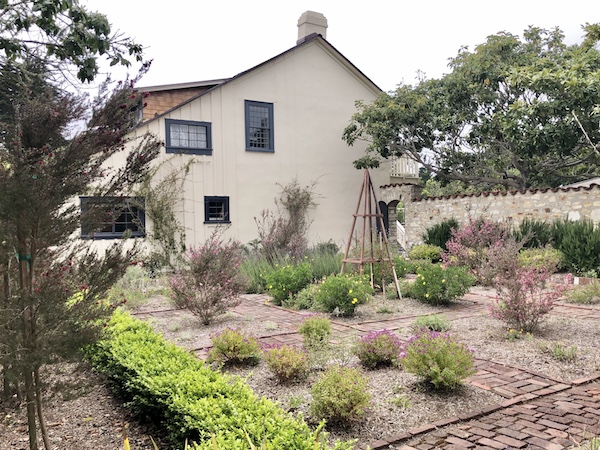
Monterey has a very colorful history. Part of that history includes the whaling industry. Just footsteps from Fisherman’s Wharf, you can view the remnants of that long ago era at the Old Whaling Station.

The Old Whaling Station’s history begins with David Wight. Mr. Wight built an adobe home for his family here in 1847 based on his ancestral home in Scotland. The Wights lived here for only a few years before joining the gold rush in 1850.

An original try-pot located behind the Old Whaling Station. After Mr. Wight’s departure, Portuguese whalers employed by the Old Monterey Company began working at the site in 1855. Second floor windows of the home were used to spot whales. After the whales were killed, their blubber was cut into pieces and rendered in huge iron “try-pots” on the beach in front of the Old Whaling Station. Whenever I hear “try-pots”, I think of the famous novel by Herman Melville, Moby Dick, and the “fishiest of all fishy places”, the “Try Pots”, where “pots were always boiling chowders. Chowder for breakfast, and chowder for dinner, and chowder for supper, till you begin to look for fishbones going through your clothes.”

The Old Whaling Station is just a short walk from Fisherman’s Wharf. The Whaling Station was in operation here for approximately 30 years. The whaling industry was spurred by an increased demand for a variety of products during the 19th century. Whale oil was used for lamps, soap, perfume and cosmetics. Whale bone was used for corsets, sizing poles, hoops for women’s skirts, and umbrellas, and blubber was used for cooking and machine oil and margarine.

Humpback Whales diving and feeding in Monterey Bay. By the 1930s, many whale populations became endangered due to massive hunting. Thankfully, whale hunting is outlawed in most countries today. Whales are staunchly protected in the Monterey area, and a plethora of whale-watching cruises are available year round (pre-pandemic), departing from Fisherman’s Wharf in Monterey and further north in Moss Landing.

Whalebone used to create sidewalk in front of the Old Whaling Station. While you are here, check out the walkway in front of the building. Whalebones, which were found plentifully on the beach here during the whaling heyday, were cut and trimmed as paving blocks for a sidewalk. The whalebone sidewalk here is one the last of its kind remaining in the United States.

Monterey’s first brick house is located just adjacent to the Old Whaling Station. The Junior League of Monterey currently leases the Old Whaling Station from California State Parks and allows the adobe and gardens to be used for weddings and other events. For more information, see Old Whaling Station or contact the Junior League of Monterey at 831-375-5356. The historical building hours prior to the pandemic were Tuesday through Friday, 10 am to 2 pm. Although the building is now closed, the garden remains open.
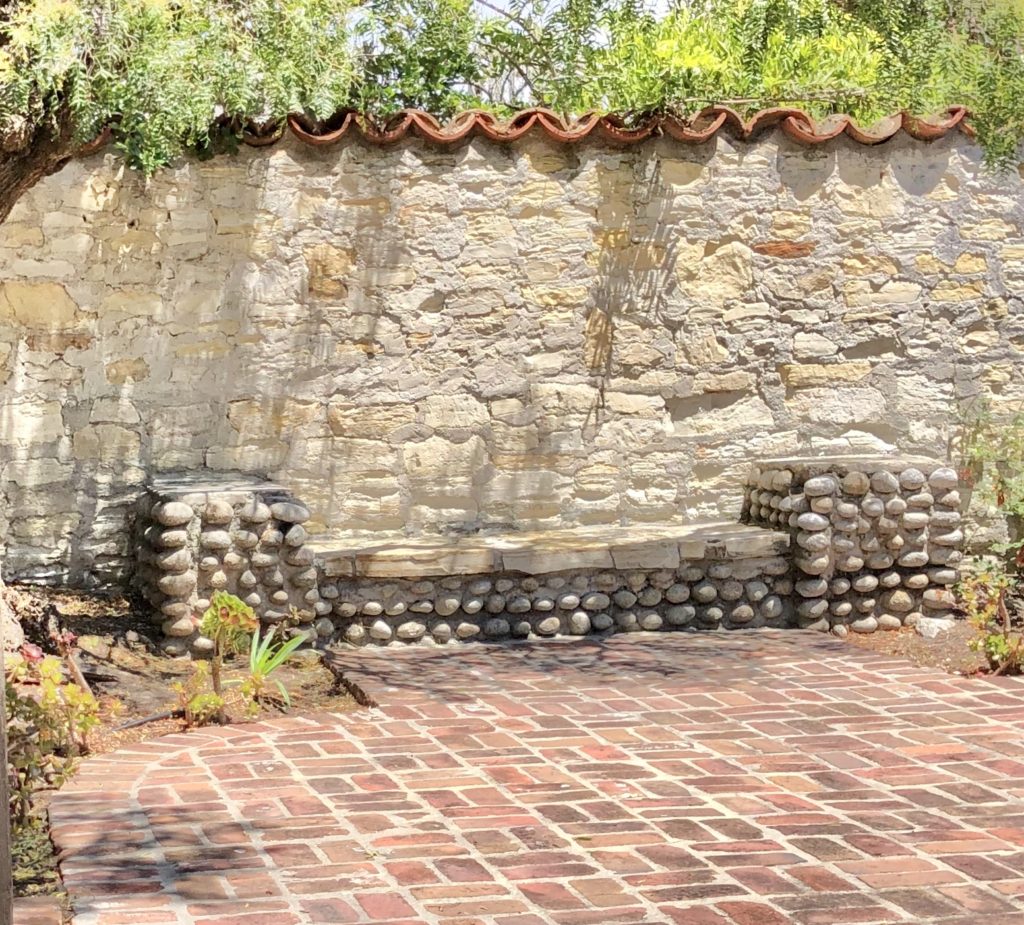
Thank you for visiting my blog. I hope you are able to visit Monterey and see the Old Whaling Station. To learn more about Monterey, you may enjoy my other posts including Adventures at the Monterey Bay Aquarium, Whale Watching & More at Fisherman’s Wharf, The Secret Gardens of Historic Monterey, Cannery Row: What to See & Do!, and Delicious Places to Eat in Monterey on a Budget. Wishing you peace, love, happiness, & beautiful vistas!
-
The Charm of Antique Watering Cans
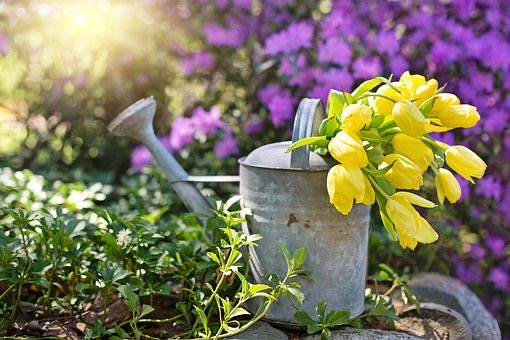
I love antique watering cans. Both functional and charming, they have been in use for hundreds of years to water plants and flowers. Before the watering can we know today, buckets and earthenware watering pots were used. These were cumbersome and often very heavy, especially after being filled with water! We have it pretty easy today with our 100 foot long garden hoses and adjustable spray nozzles. These people would likely call us gardening sissies!

Early French copper watering can. 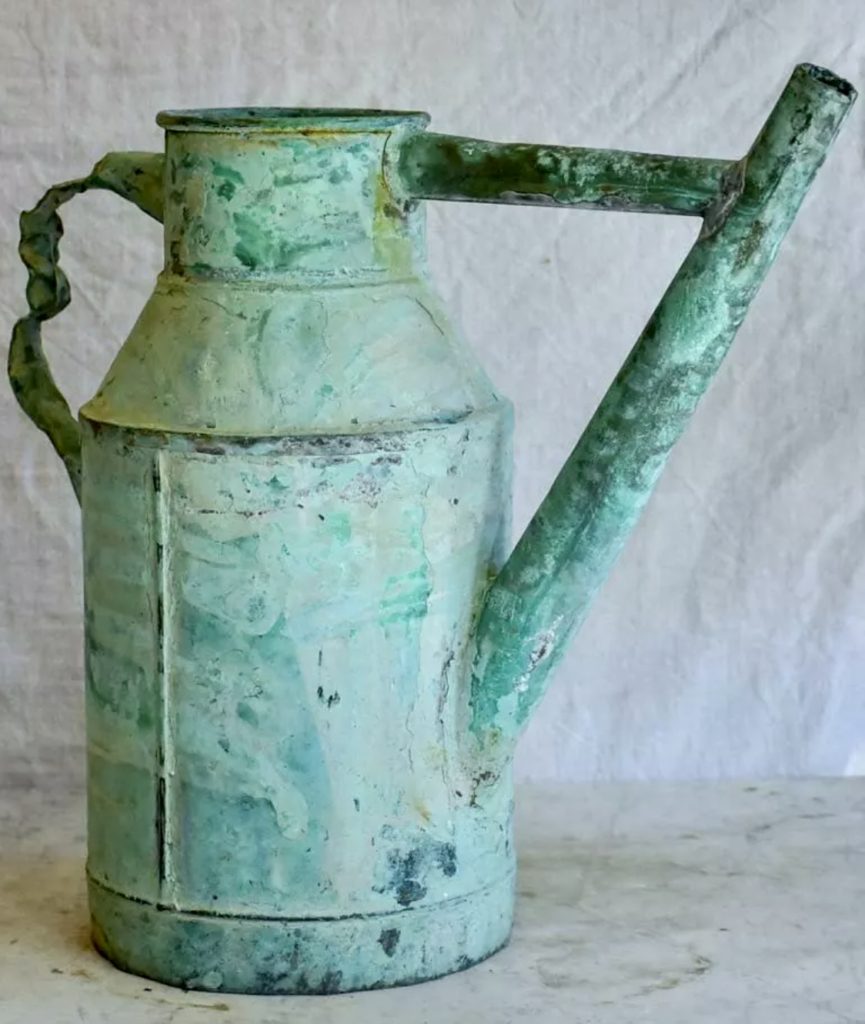
Another early French copper watering can with a distinctive blue patina. The humble watering can has undergone many changes. In the late 1600s, watering cans began to be constructed of copper. Then, during the mid-1800s, they were also produced in brass and zinc. Antique French watering cans of yore often resembled large pitchers, often with graceful and elegant handles. American watering cans tended to be larger and bulkier.
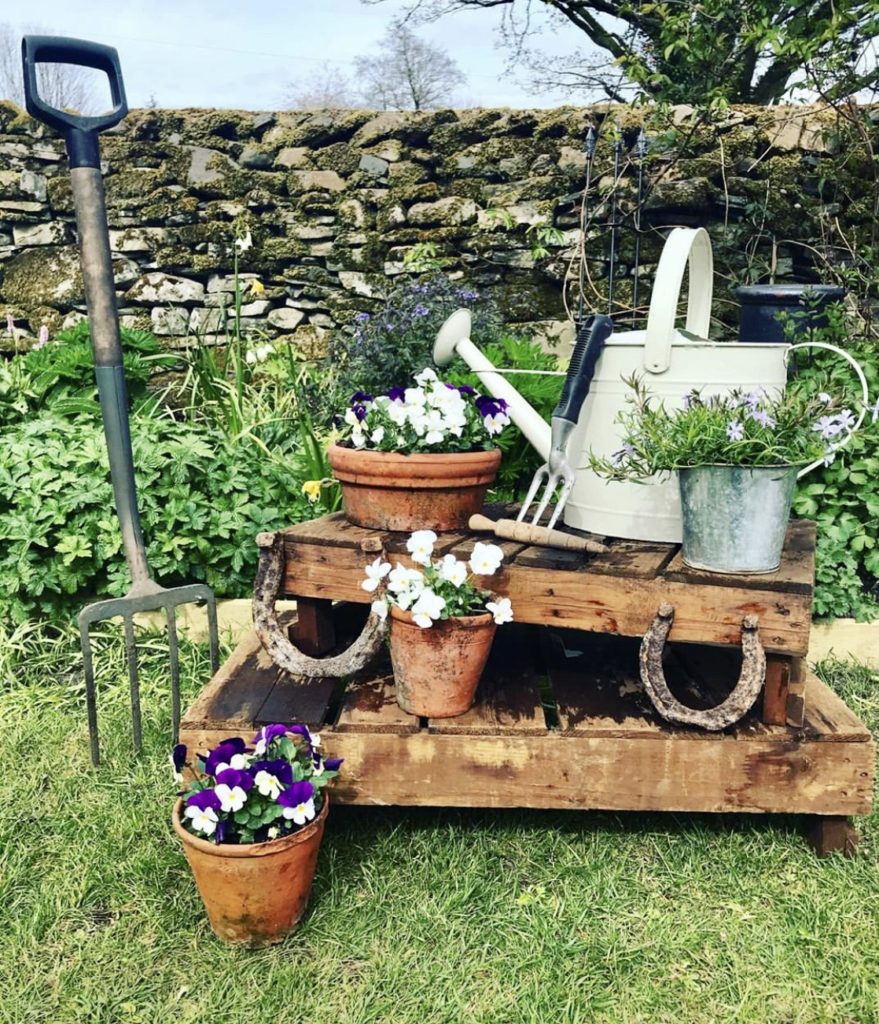
Photo courtesy of @lane.end.cottage 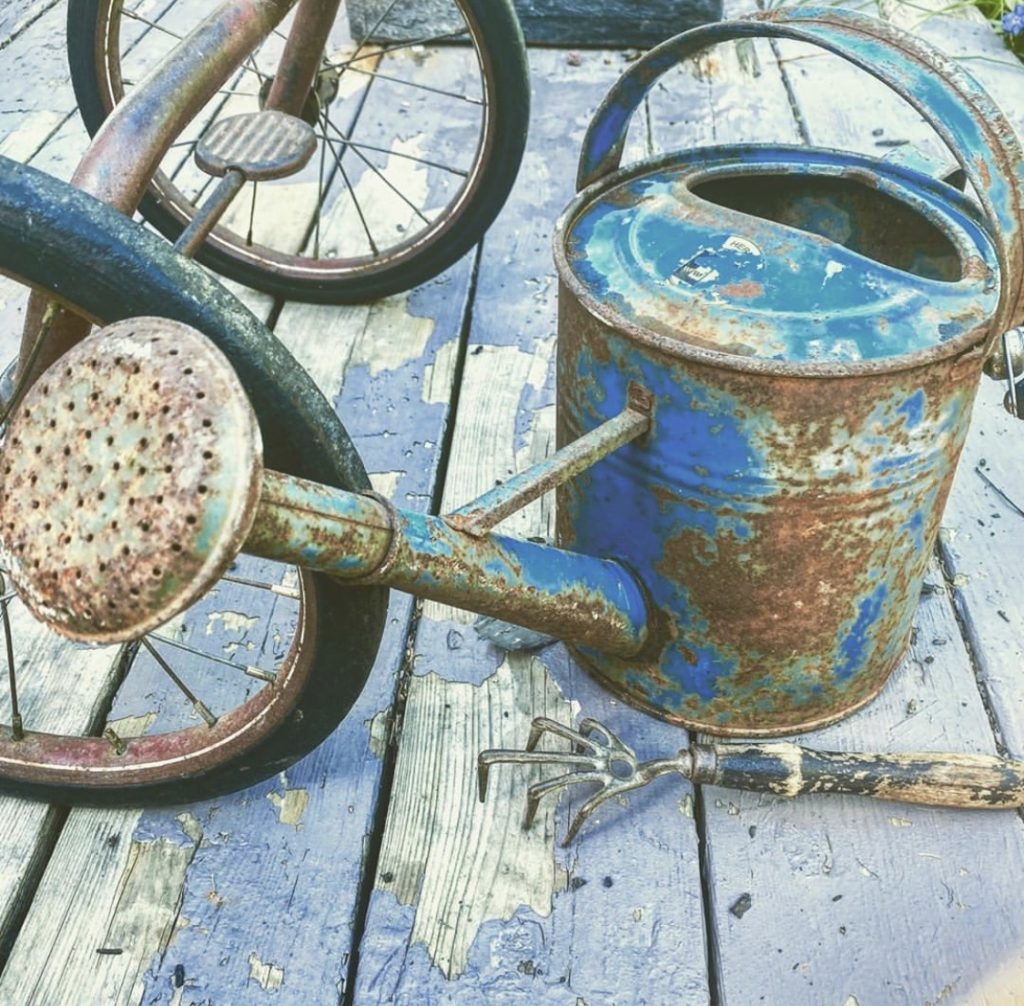
Gardening became extremely popular during the Victorian era. Due to a craze for ornamental gardens and greenhouses, the need grew for better watering cans. In 1886 the Haws Company came to the rescue. This English business revolutionized the humble watering can by creating a longer spout and two handles: one on the top for carrying, and one on the back for tipping and pouring. The Haws watering can remains a classic today.
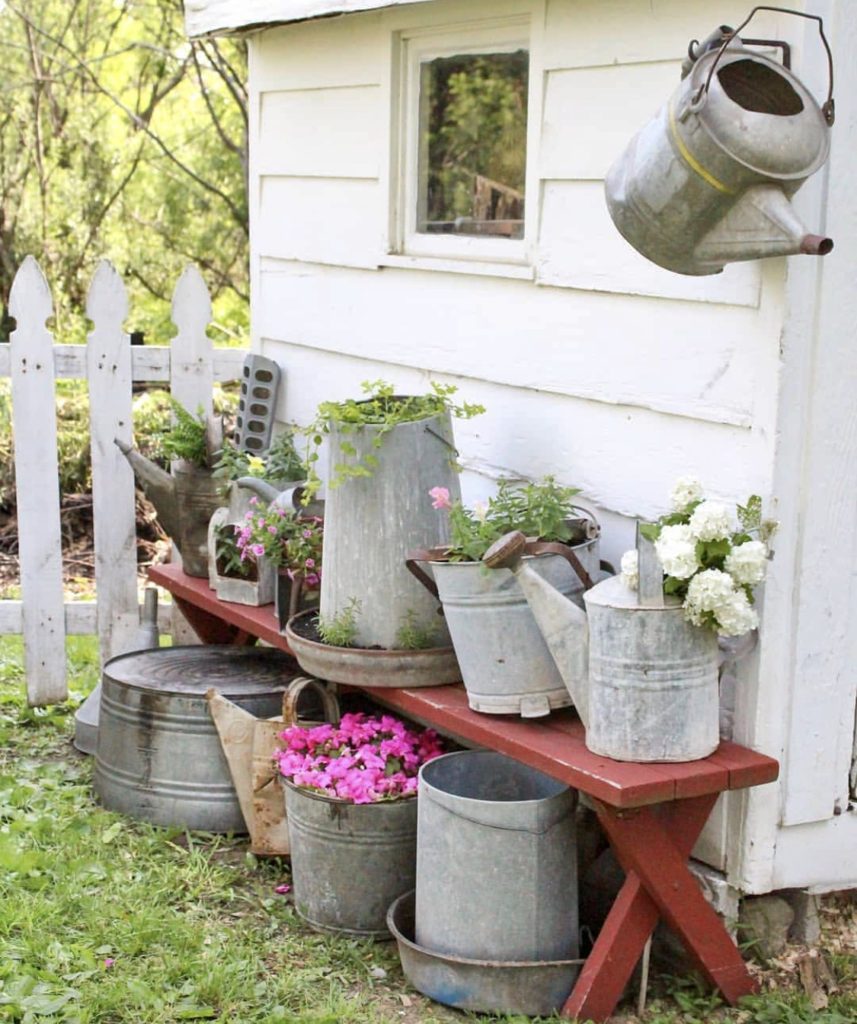
Photo courtesy of @countryfirsts 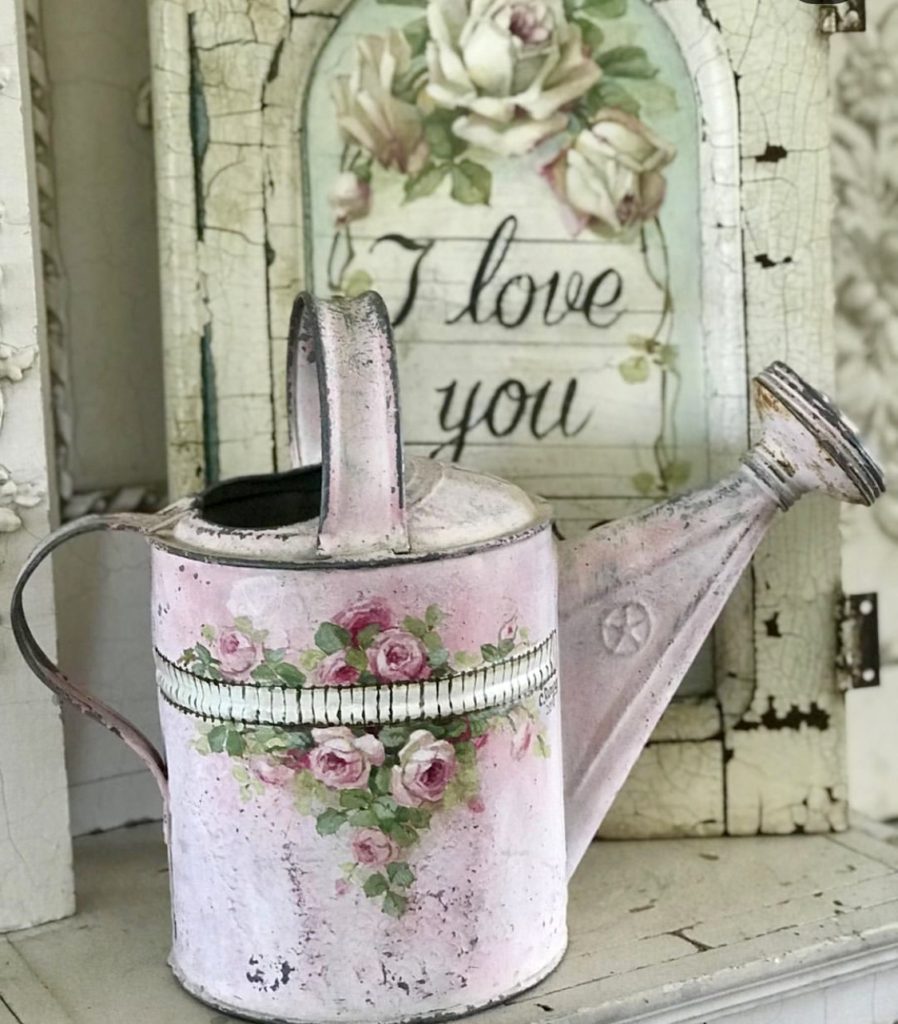
Photo courtesy of @shabbytownusa11 Another addition to watering cans was the use of a detachable sprinkling “rose” on the tip of the spout. It enabled the control of water flow, creating a gentle trickling of water from a multitude of tiny holes, versus a heavy torrent. Its name is derived from the French word “arroseur”, meaning sprinkler.
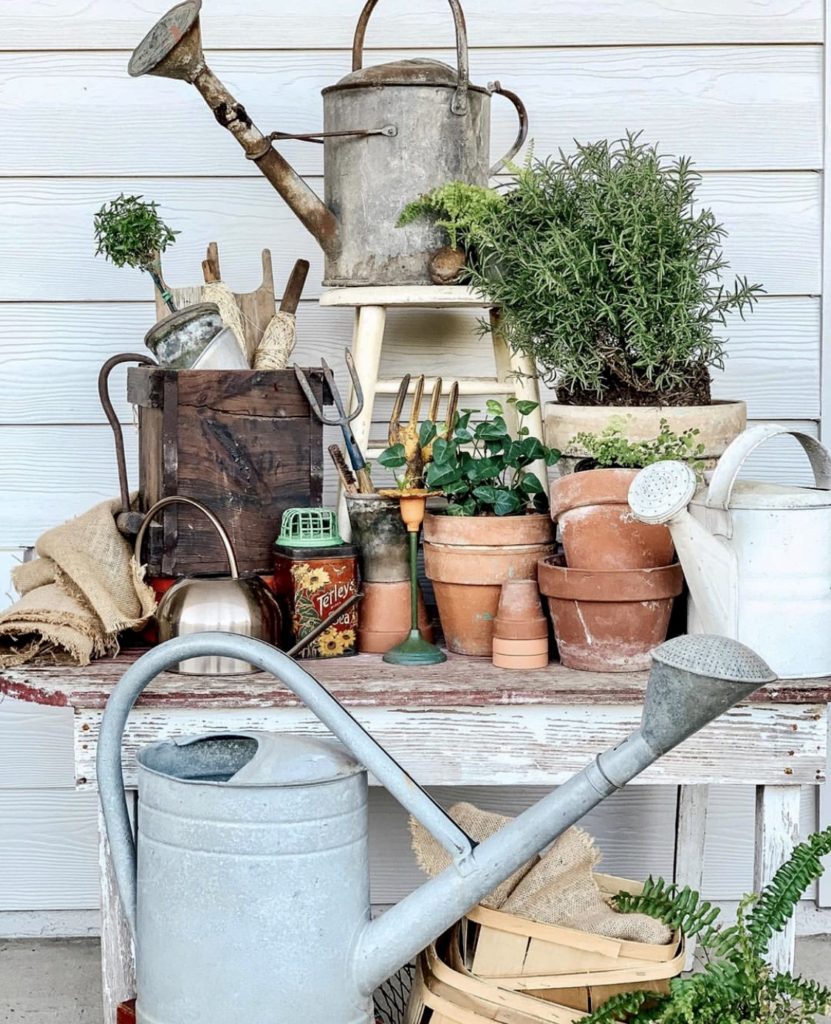
Photo courtesy of @weatheredwaresandco Galvanized metal watering cans became plentiful in the early 1900s. These are the most common antique watering cans found today.
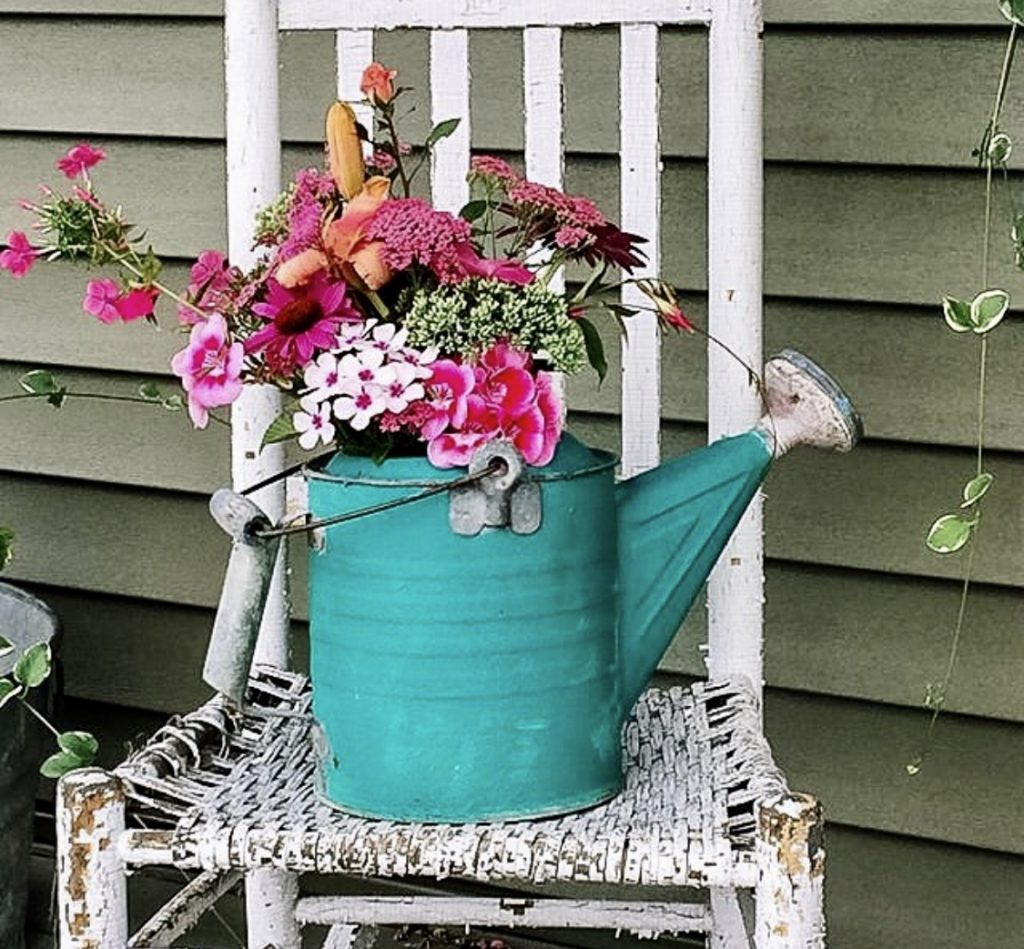
Photo courtesy of @tinyvintagefarmhouse While early antique watering cans often sell for hundreds of dollars, later models can often be found for a more reasonable price at yard sales, flea markets and online sites such as eBay and Etsy. These may have dings and dents, but that is what adds character!
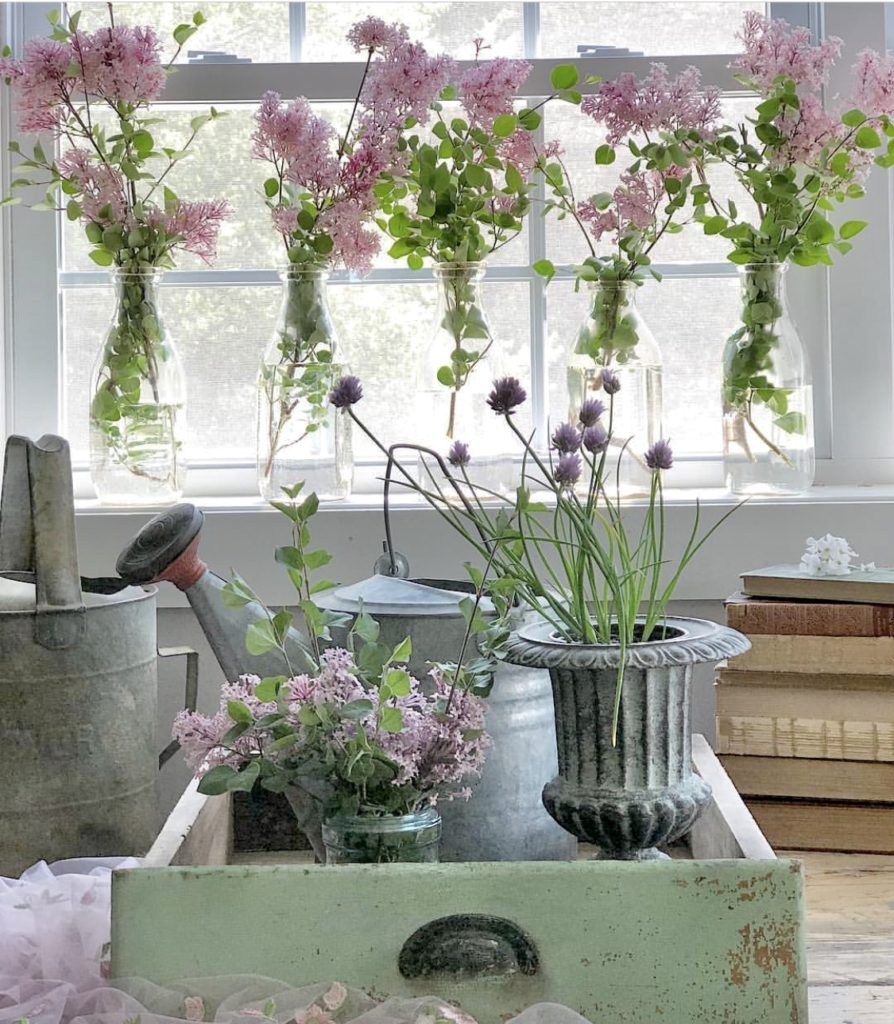
Photo courtesy of @rachelsgarden_artbyamy Even if you don’t have a green thumb, you can create charming vignettes using watering cans. Whether painted, filled with flowers, or hung on hooks, they can add warmth and a one-of-a-kind vibe.
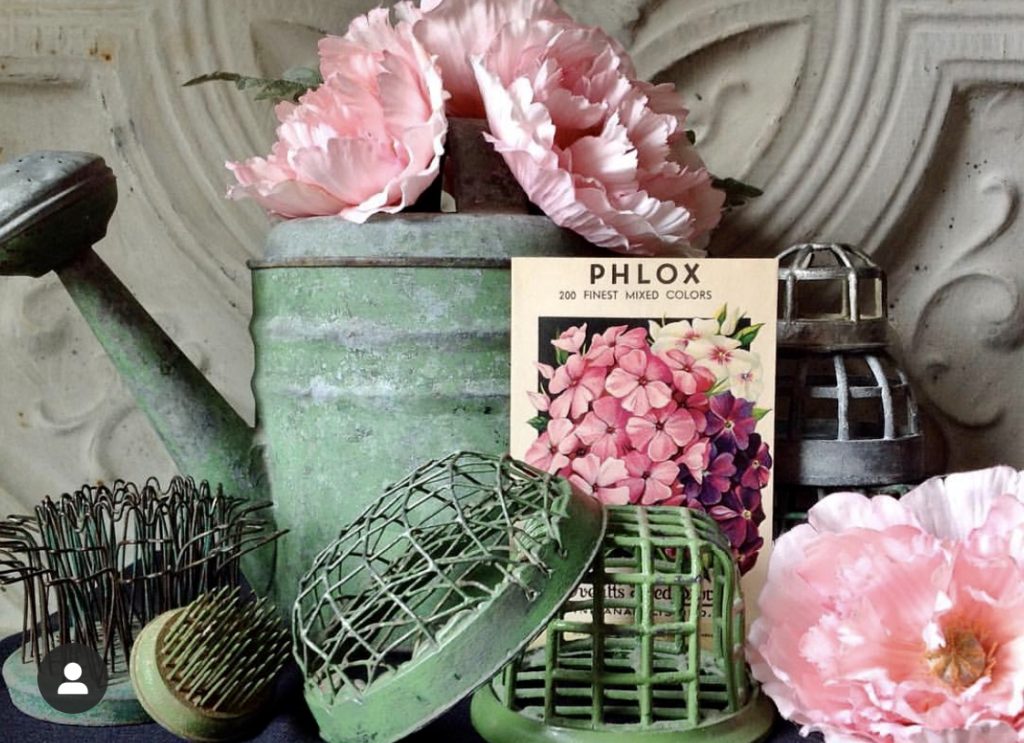
Photo courtesy of @brocante_victoria Some folks like to collect different sizes or styles and group them together.
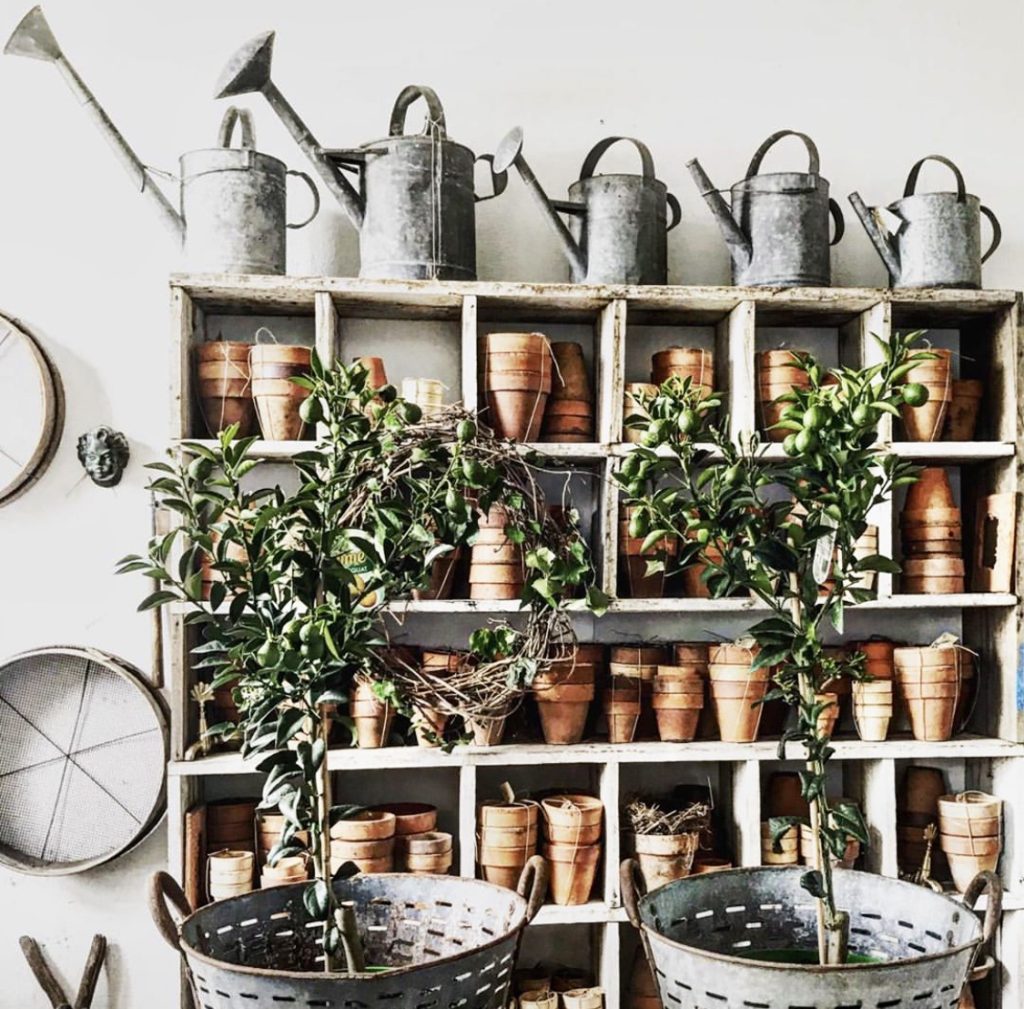
Photo courtesy of @vintage.216 You can change your watering can decor along with the seasons. Your imagination is the limit!
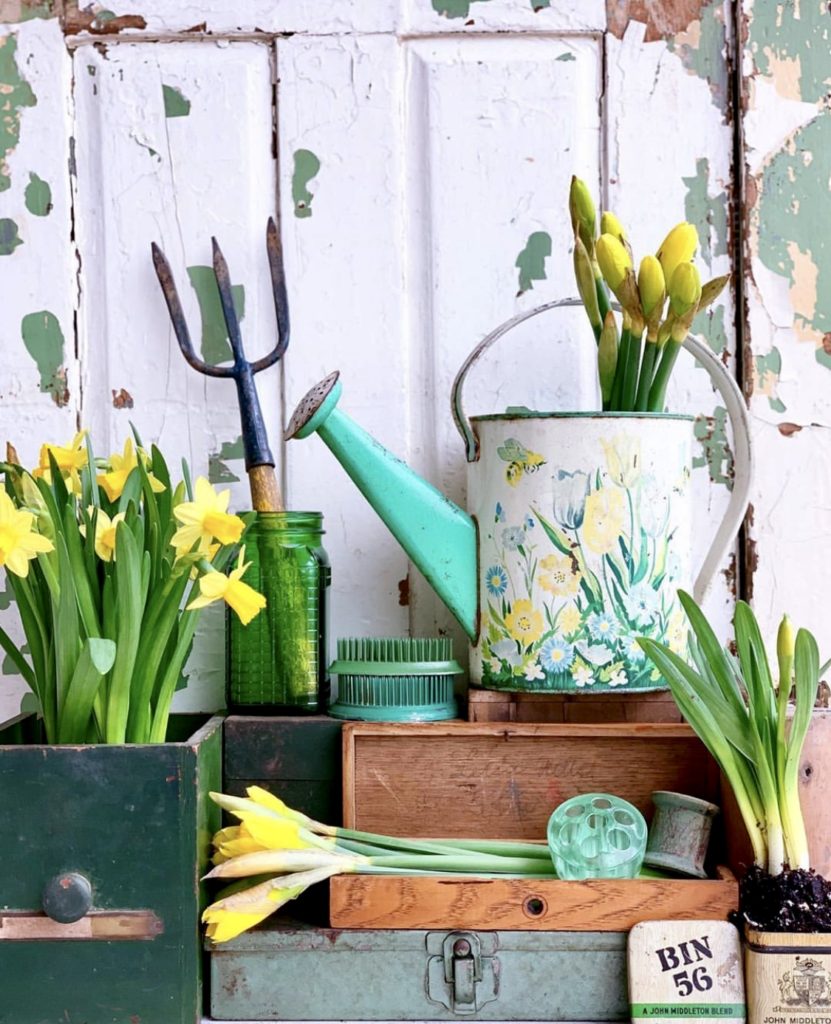
Photo courtesy of @weatheredwaresandco I hope you enjoyed this post and gained some watering can inspiration! For more information, see Antique Watering Cans, Antiques From The Garden, by Alistair Morris, and Garden Tools by Suaznne Slesin, Guillaume Pellerin, and Stafford Cliff. You may also enjoy some of my other gardening posts, including Have a Seat: Garden Bench Inspiration, Add Charm to your Garden with Beautiful Birdhouses!, and The Secret Gardens of Historic Monterey
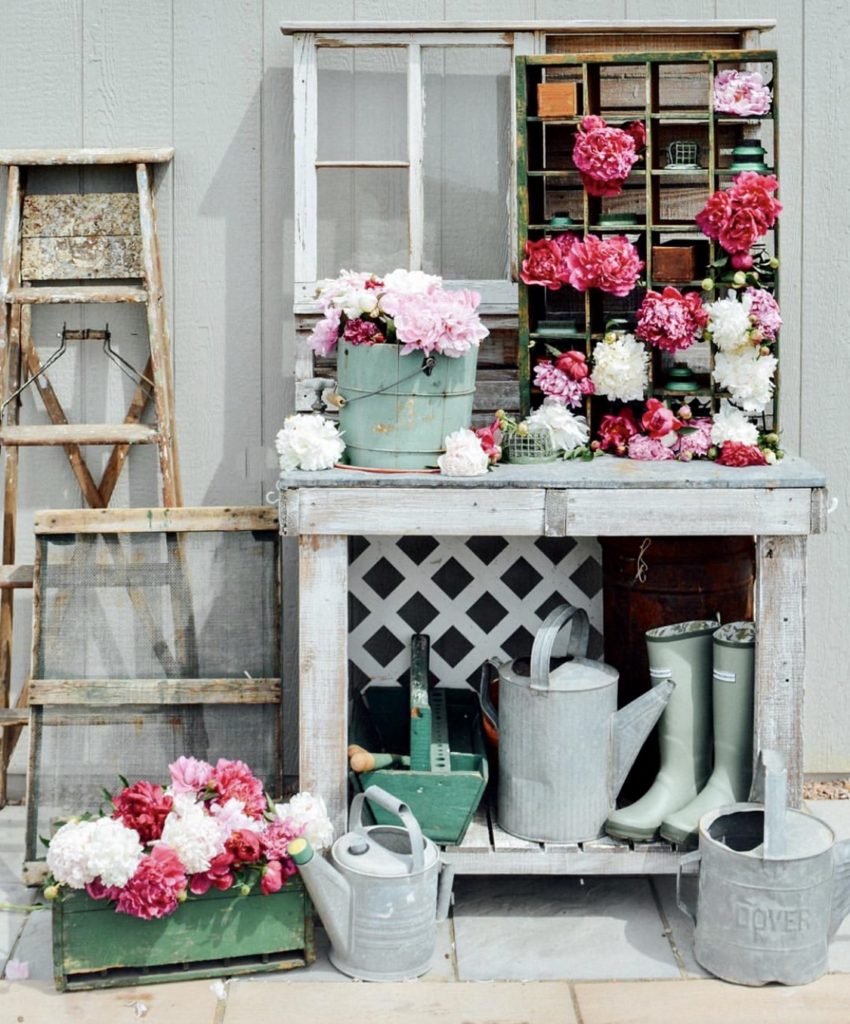
Photo courtesy of @thevettelfarm 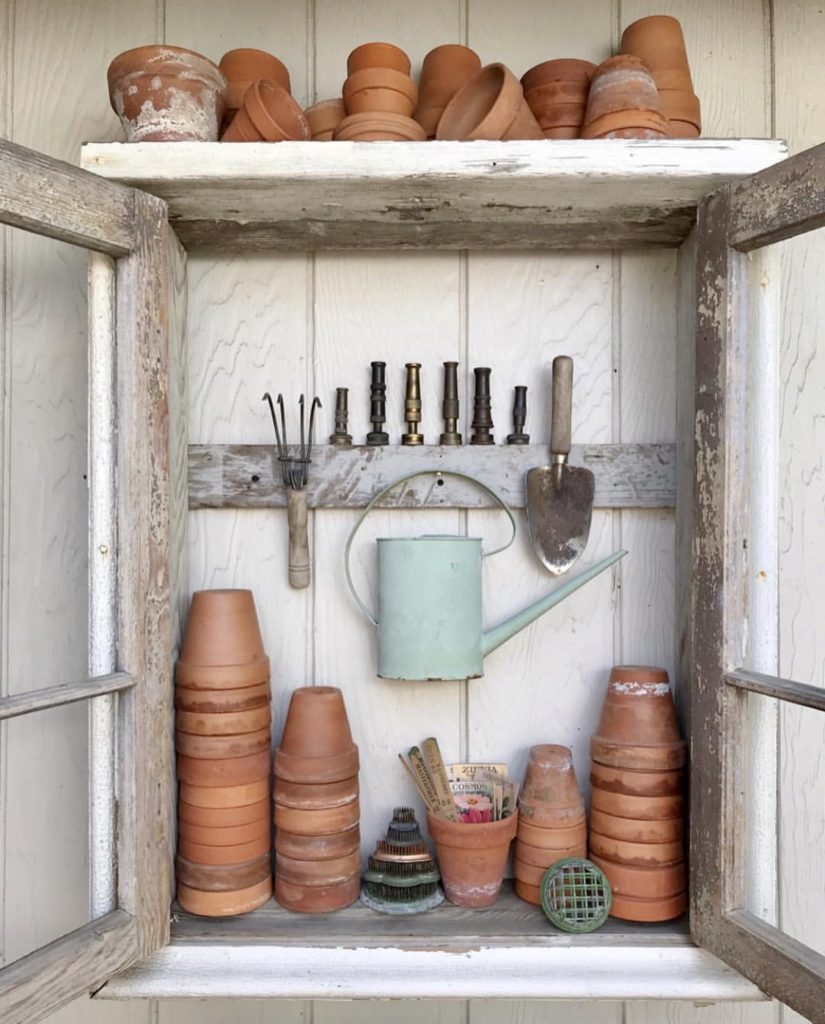
Photo courtesy of @toile_de_jute Wishing you peace, love, happiness and beautiful vistas!
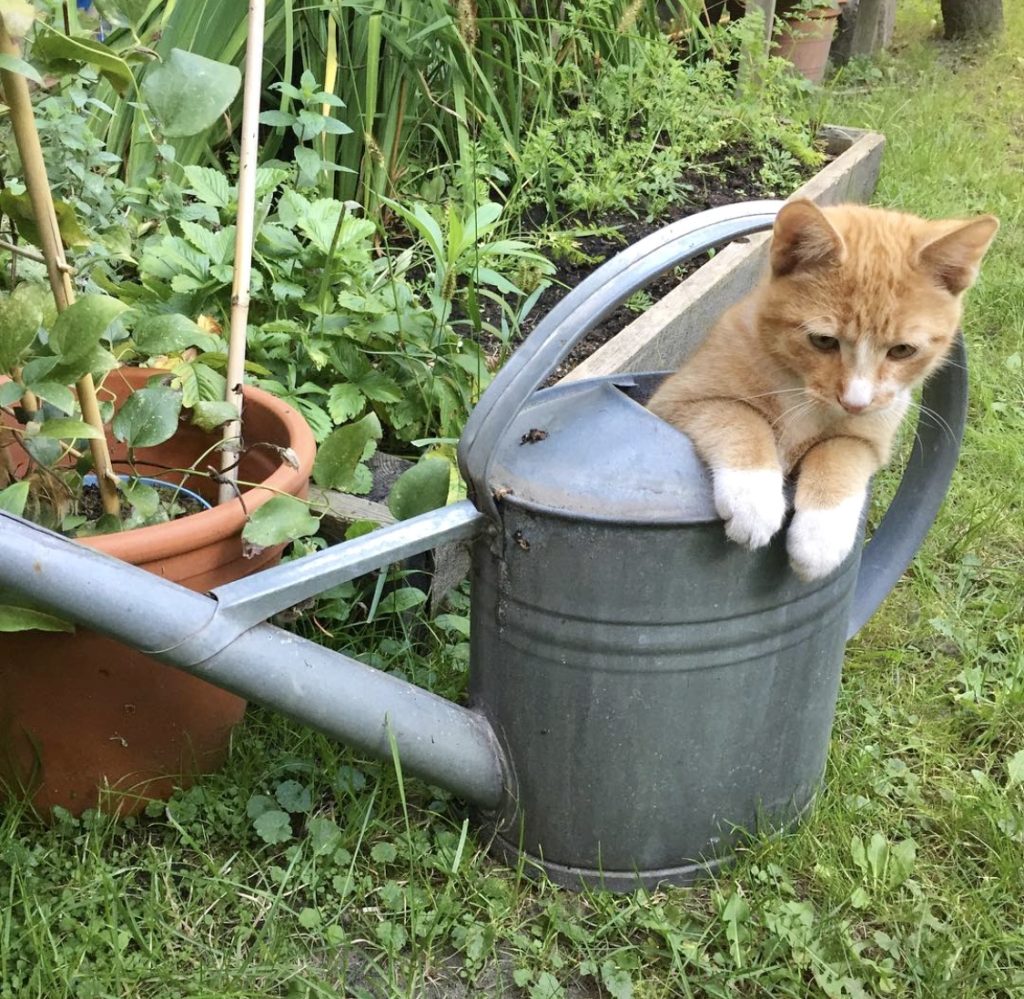
Photo courtesy of gosia_kozlowska -
Have a Seat: Garden Bench Inspiration
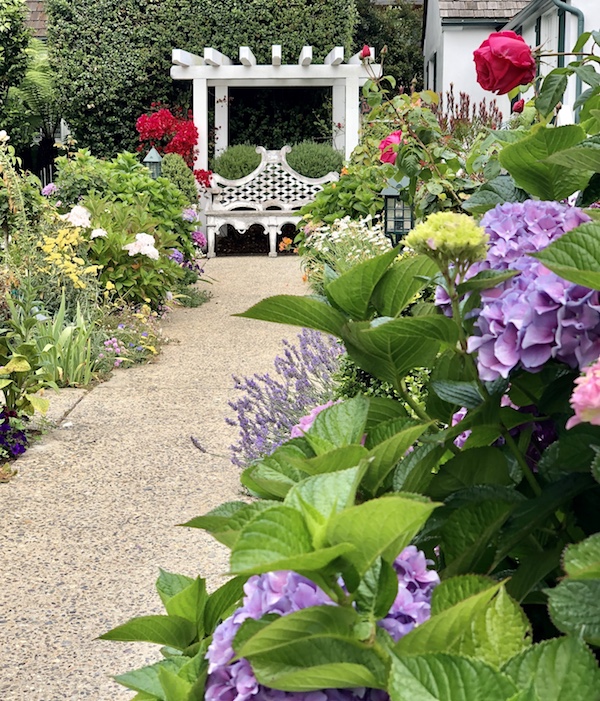
A lovely bench topped by a pergola at Lincoln Green Inn in Carmel-by-the-Sea. Benches are the perfect accessory for any garden. They offer a place to relax, enjoy the flowers, dream, read, and watch the birds & butterflies. There is nothing better than having a comfy garden bench on which to rest after a hard day’s gardening. They can also add style, grace, and character to your outdoor space.
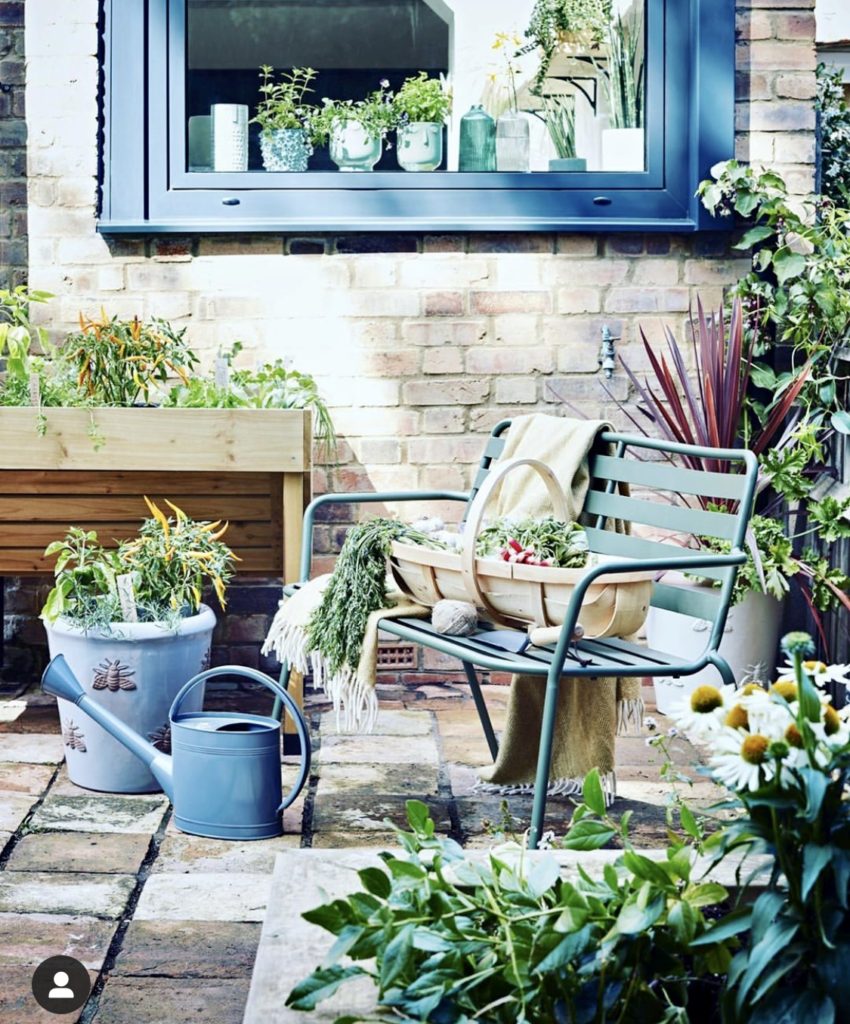
Photo courtesy of @selinalake Garden benches come in a wide variety of materials, the most common are wood, metal, concrete and stone.
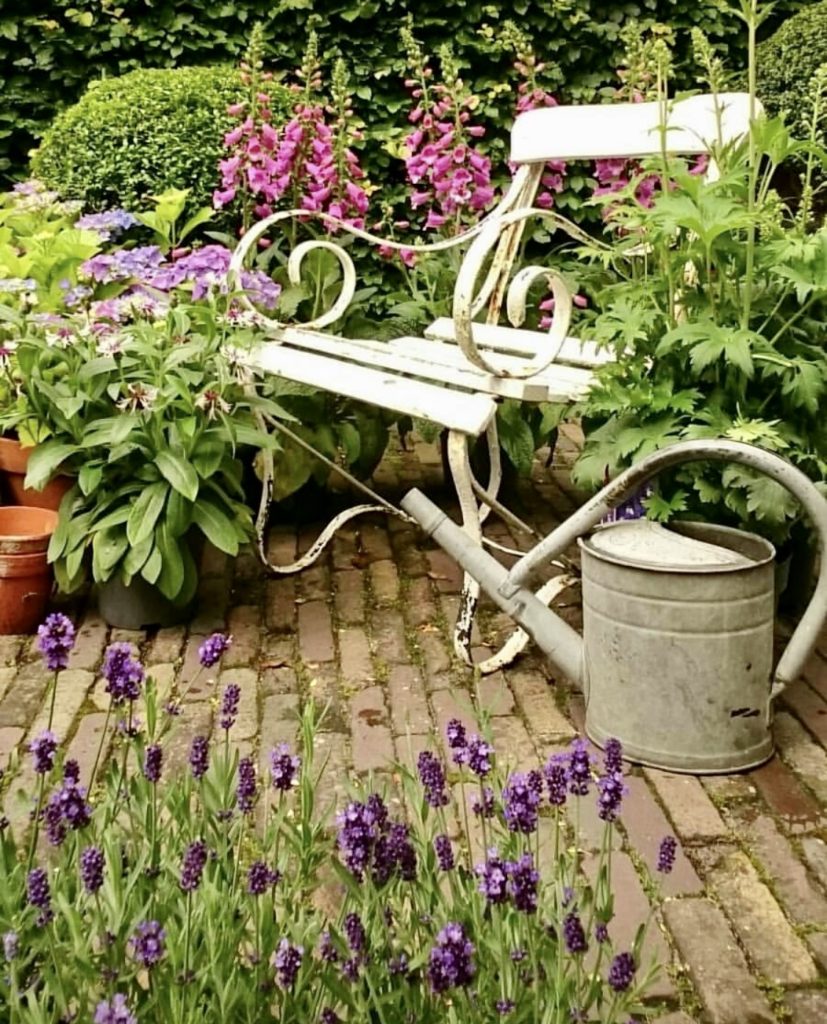
Photo courtesy of @country.chique Natural wood is one of the most common materials used in garden benches. While it can be susceptible to weather damage and pests, it is easily protected with paint, oil or varnish. In colder climates, covering it over the winter will also help improve its lifespan. Regular cleaning of wood benches is also important to help preserve them. For more information see protecting wood benches.
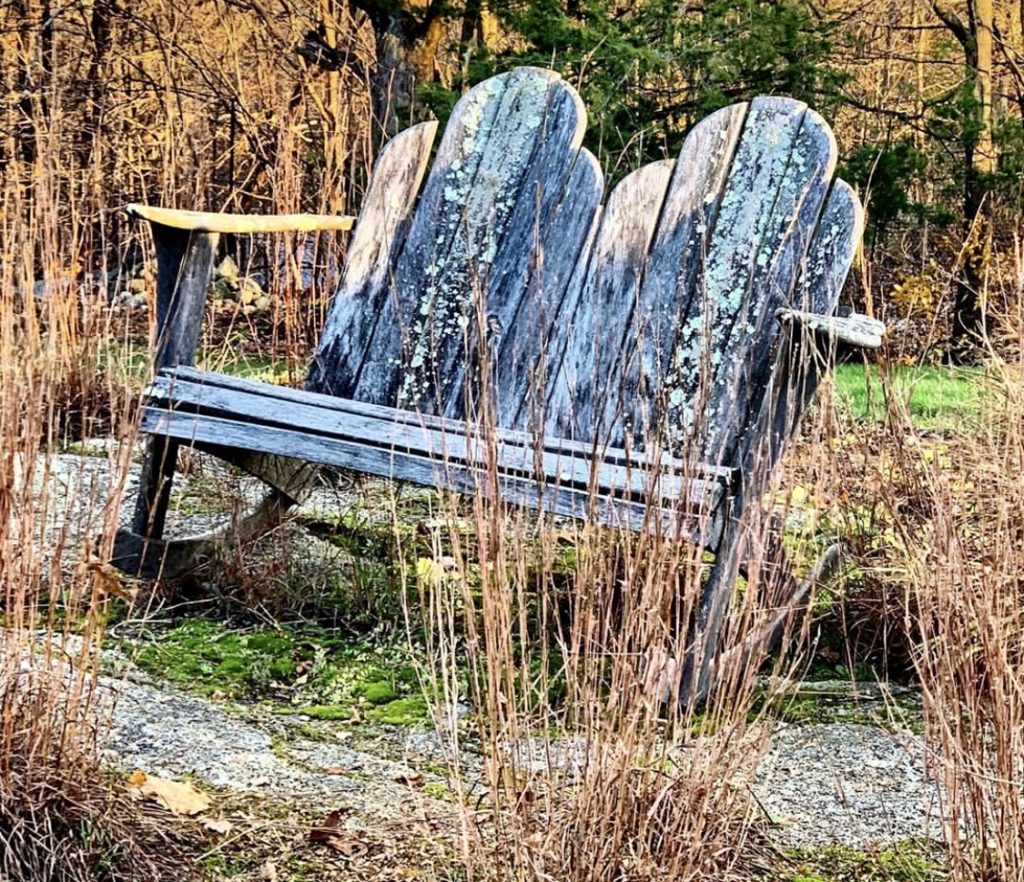
For those who like the look of weathered wood, you can forgo maintenance and let nature take its course. Photo courtesy of @pixieperennials 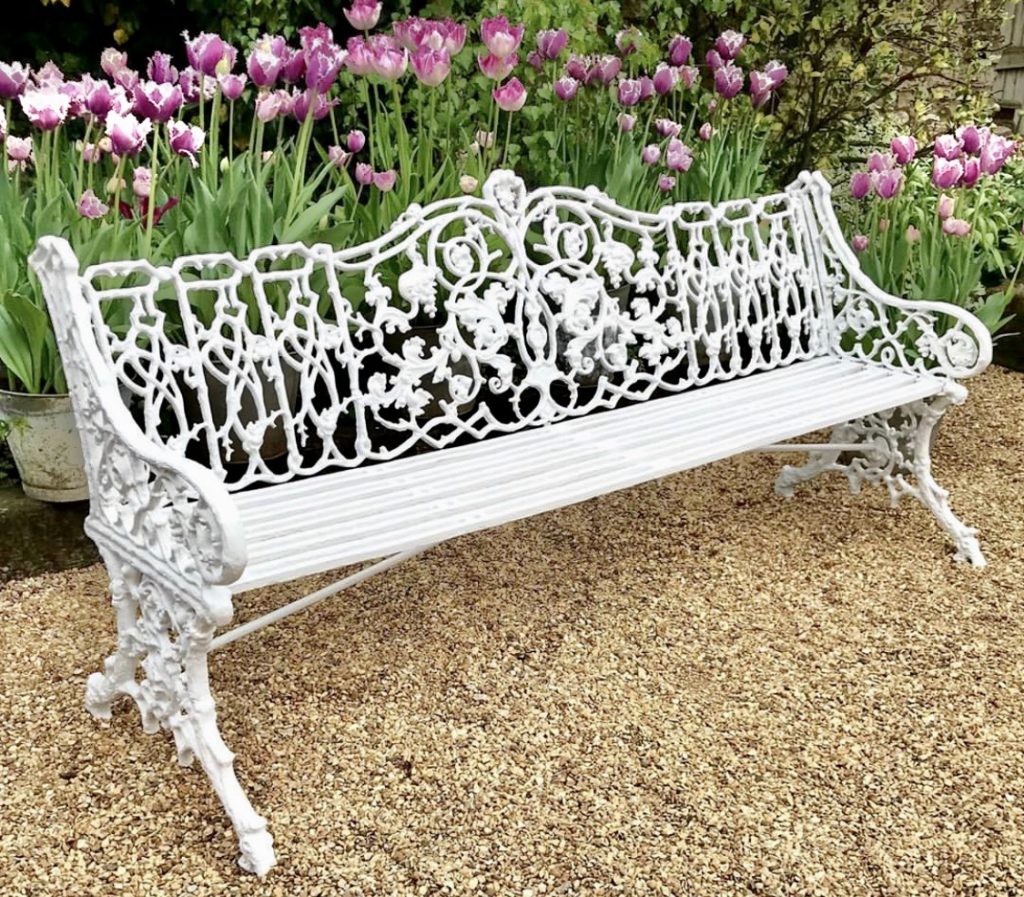
Photo courtesy of @thompsonsgardenemporium Metal benches are often made of steel, cast iron, or aluminum. Metal benches are often fantastically ornate. Many vintage and antique benches are metal. Metal benches require paint and protective sealants to prevent rusting. Like wood benches, they also require regular cleaning to remove accumulated dirt and grime that may deteriorate the finish. They also require covering or storing indoors in colder climates during the winter season. For more information on protecting metal benches, see protecting metal benches
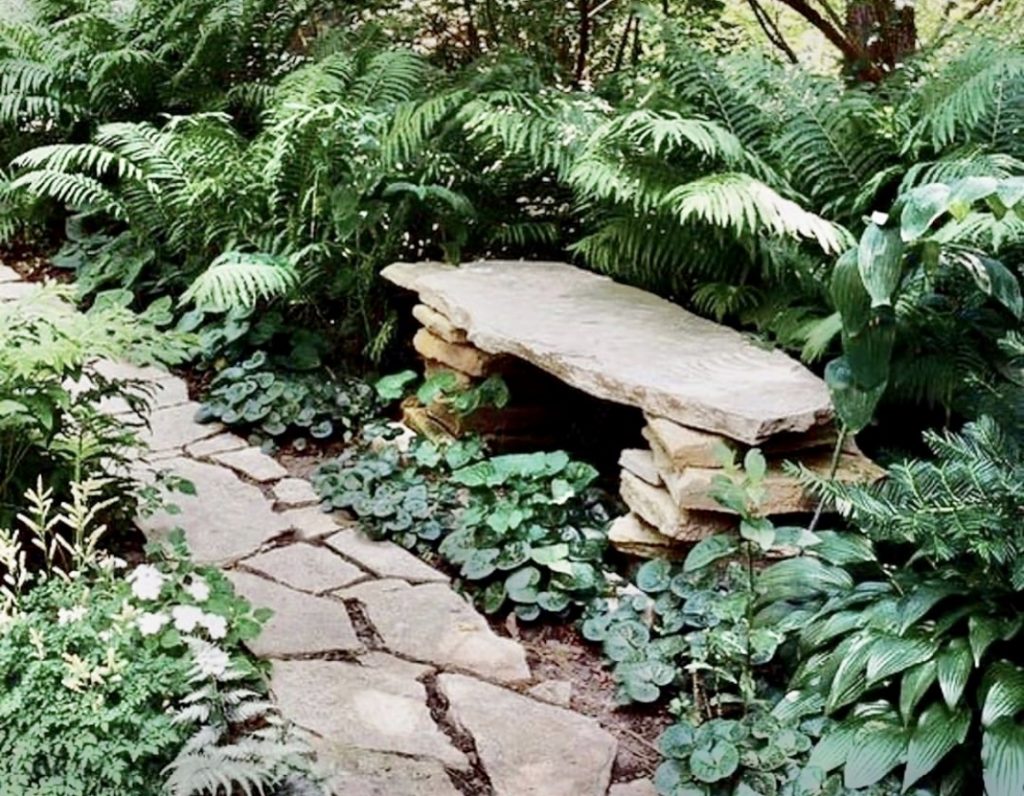
Photo courtesy of @homecompanion Stone and concrete benches add a natural touch and have exceptional longevity. A big plus is they require virtually no maintenance.

Stone swan bench available at tuscanbasins.com Garden benches can add a focal point to your garden. They also provide a place to spend time with friends and family and enjoy an intimate conversation within the garden.
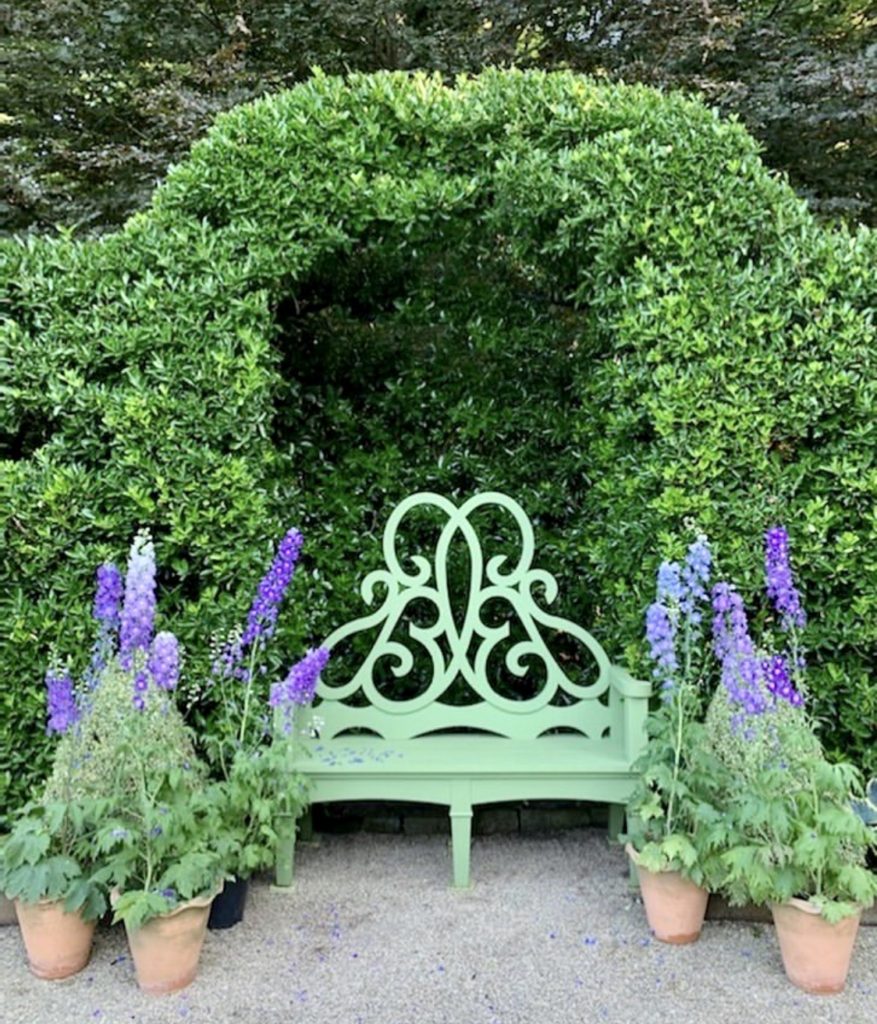
Photo courtesy of @privatenewport 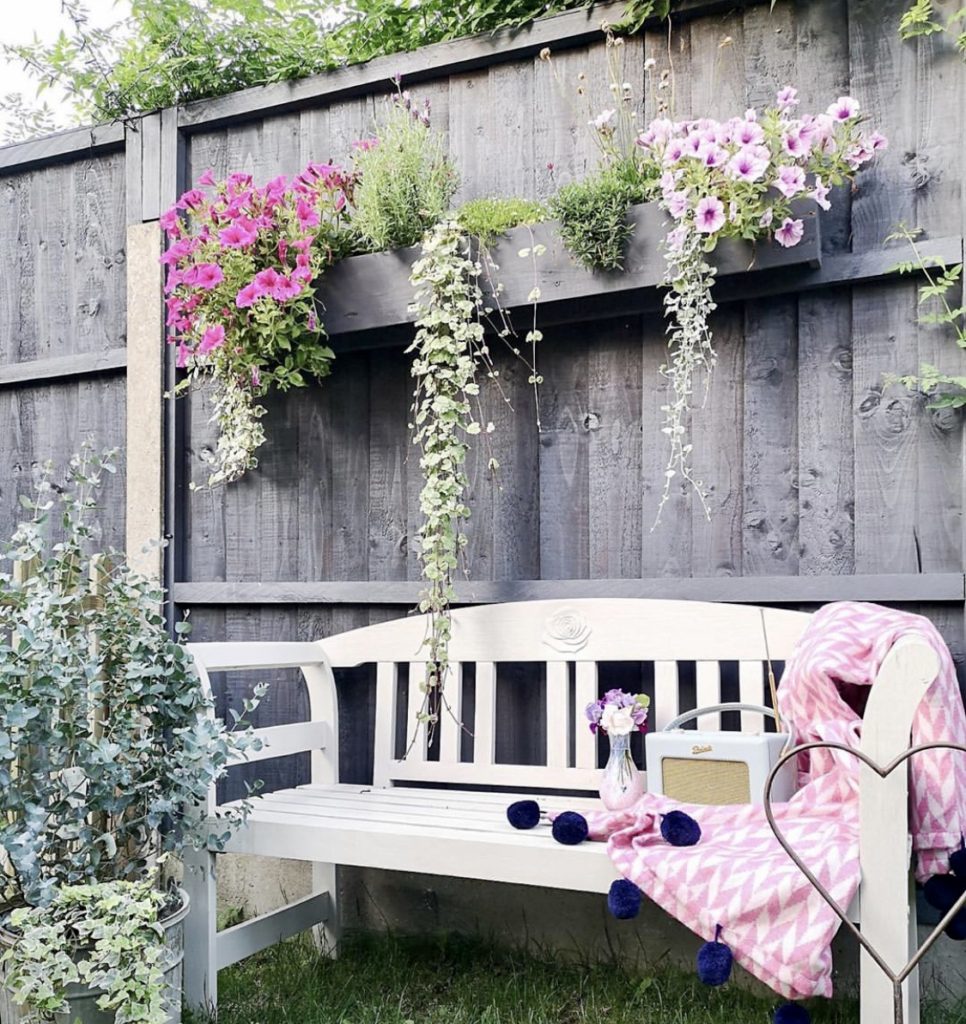
Photo courtesy of @ourlittleflintcottage You can add personality to your garden by adding a splash of color. A kaleidoscope of garden benches are available for sale online as well as in brick & mortar stores, or you can paint your own!
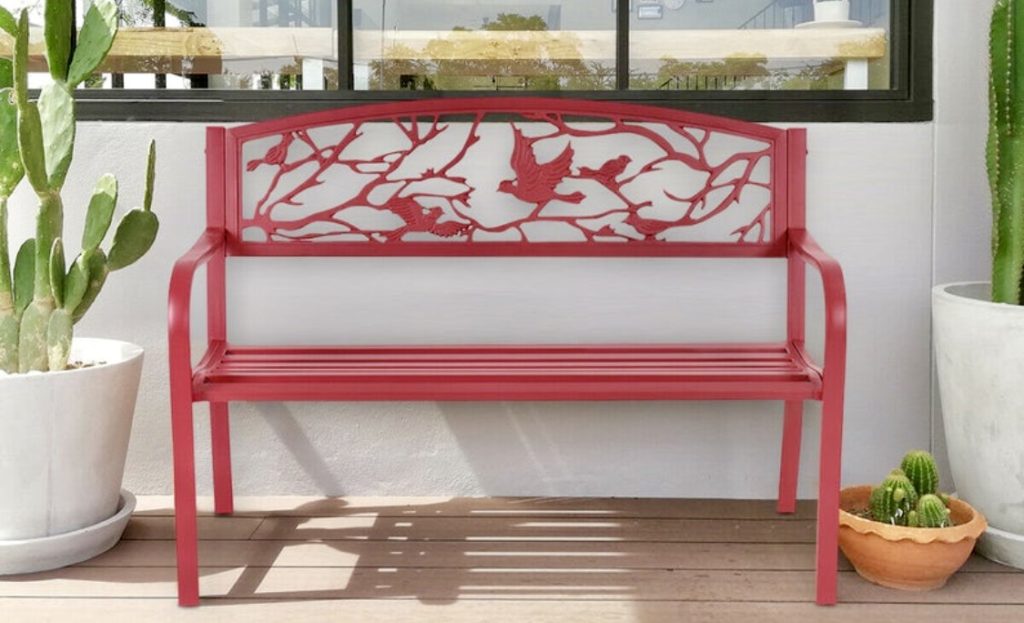
Bold red bird bench available on Etsy.com 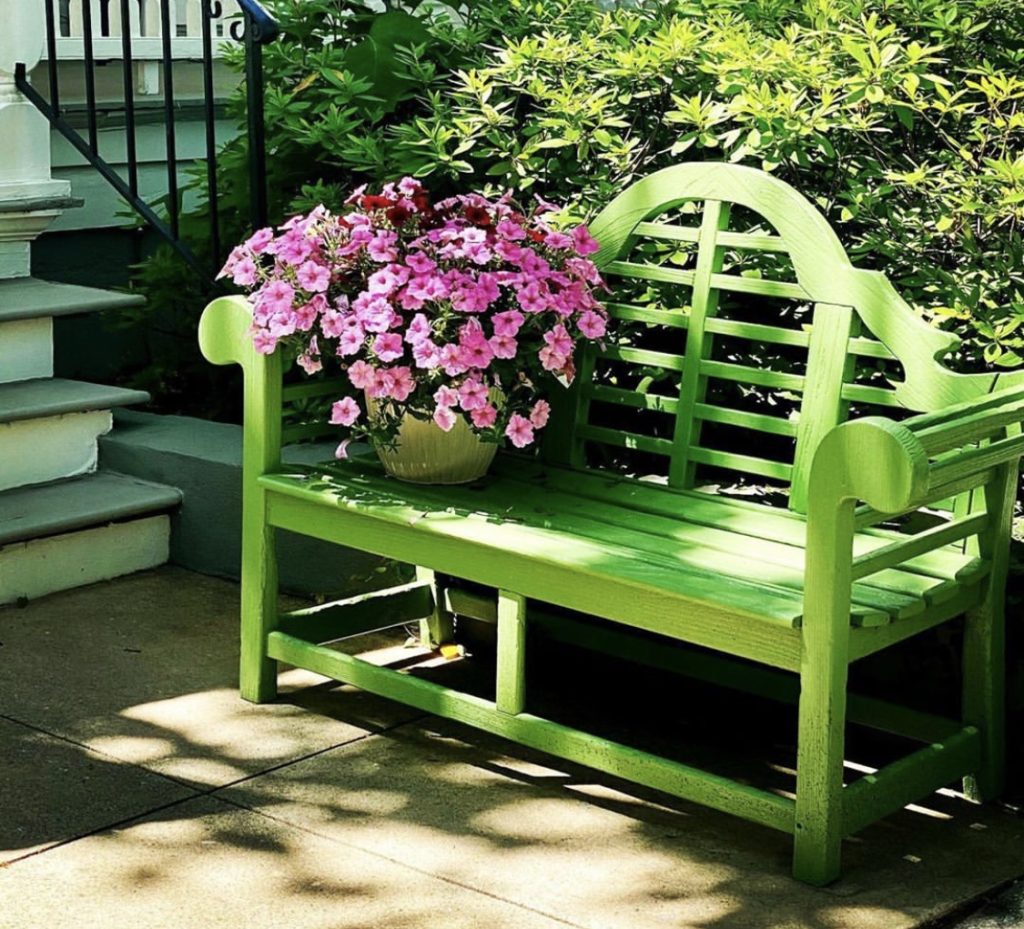
Traditional Lutyens bench painted a happy shade of green. Photo courtesy of @asnipofgoodness Creative folks can repurpose items and invent their own unique garden benches.
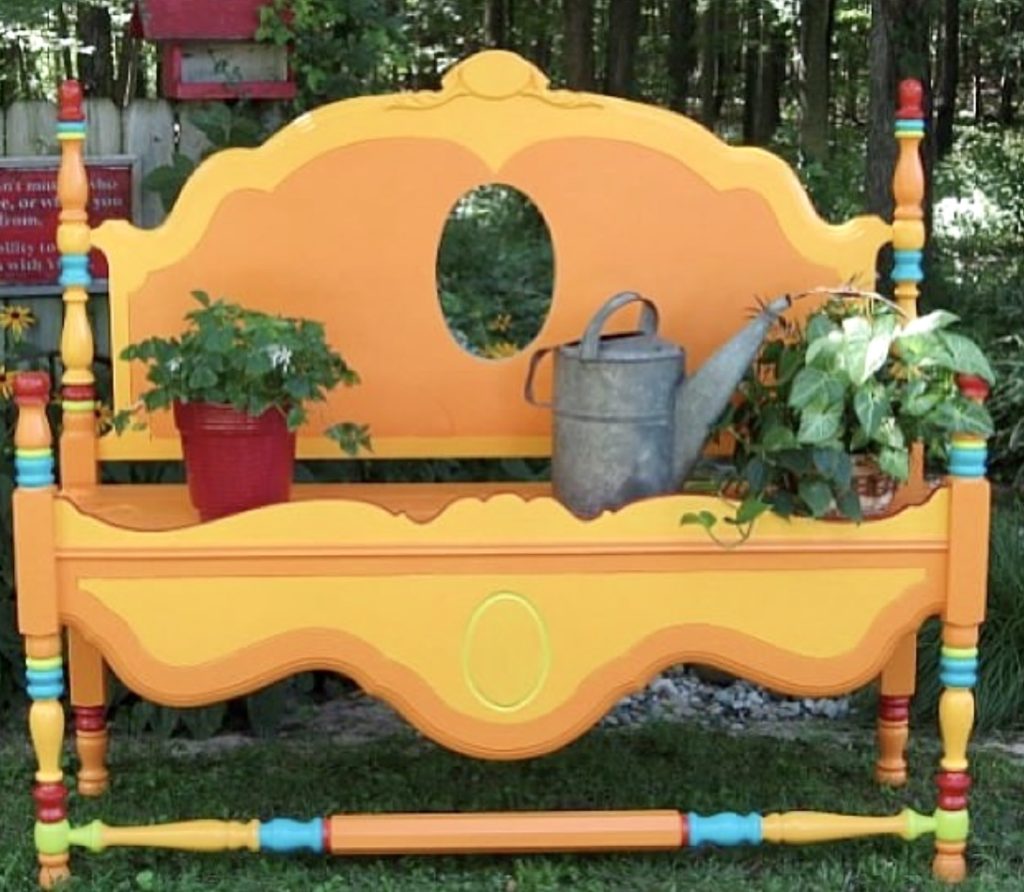
Garden bench repurposed from a vintage bed. Photo courtesy of @home_decoranddesign 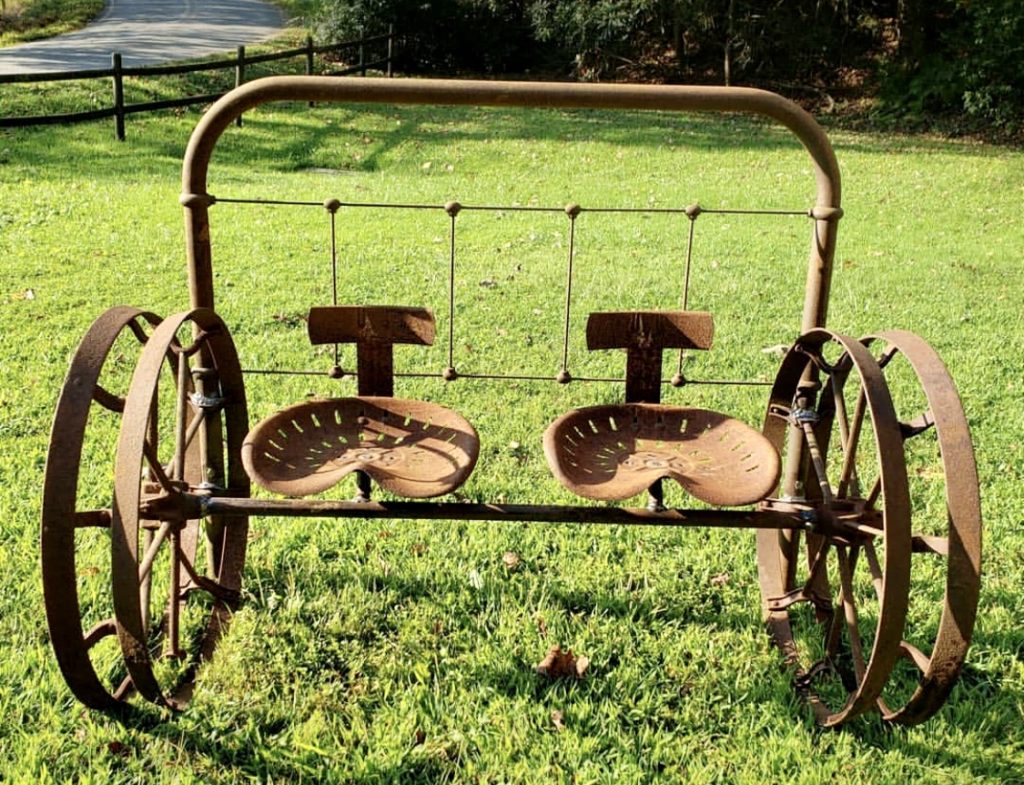
Garden bench constructed from old farm wheels and tractor seats. Photo courtesy of @rusticremakes You may want your garden bench prominently displayed, or tucked secretively away where you can hide from the cares of the world with a cup of tea (or glass of wine) and your favorite book.
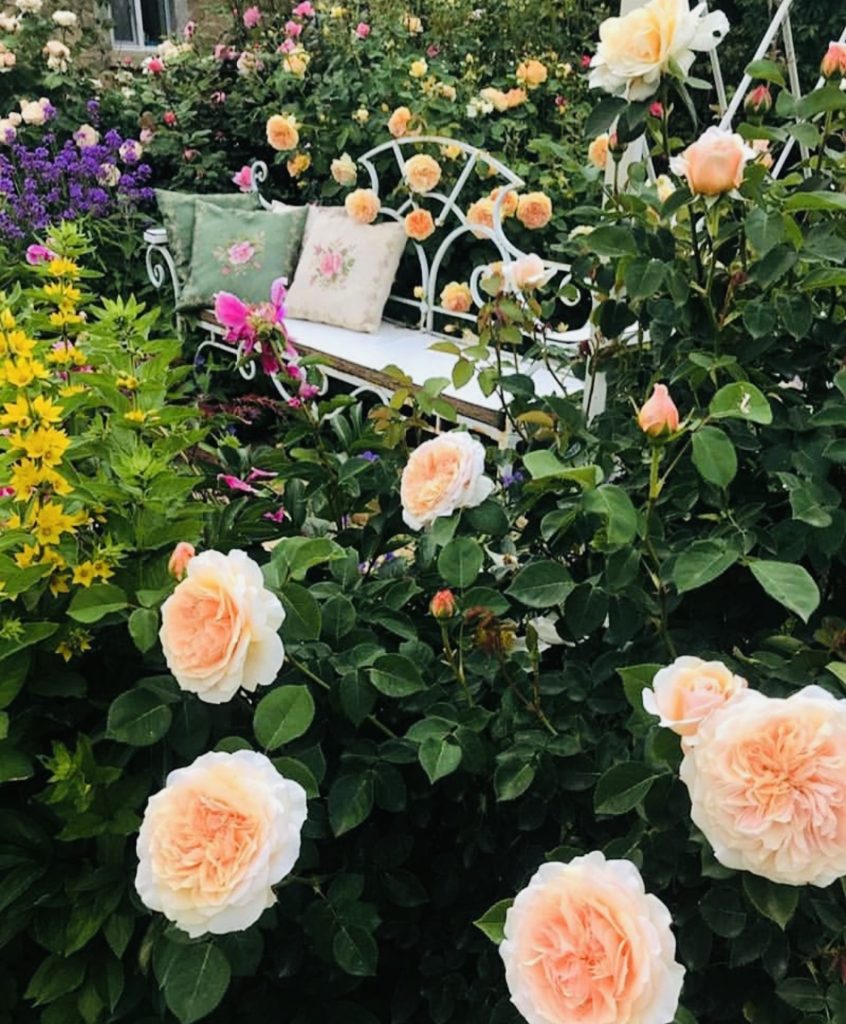
Photo courtesy of @gardens_and_architecture I love roofed benches, which provide a refuge from both raindrops and hot sun in the garden.
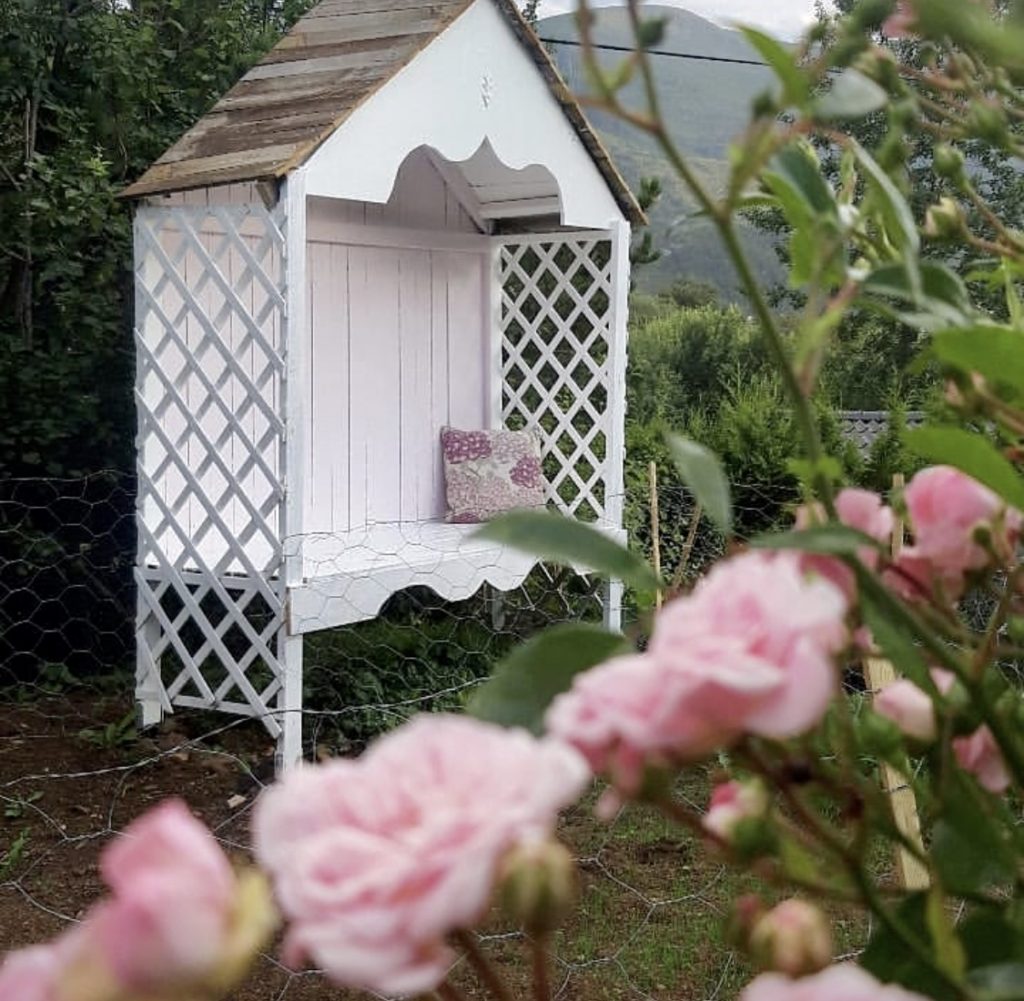
Photo courtesy of @sammensuriumet 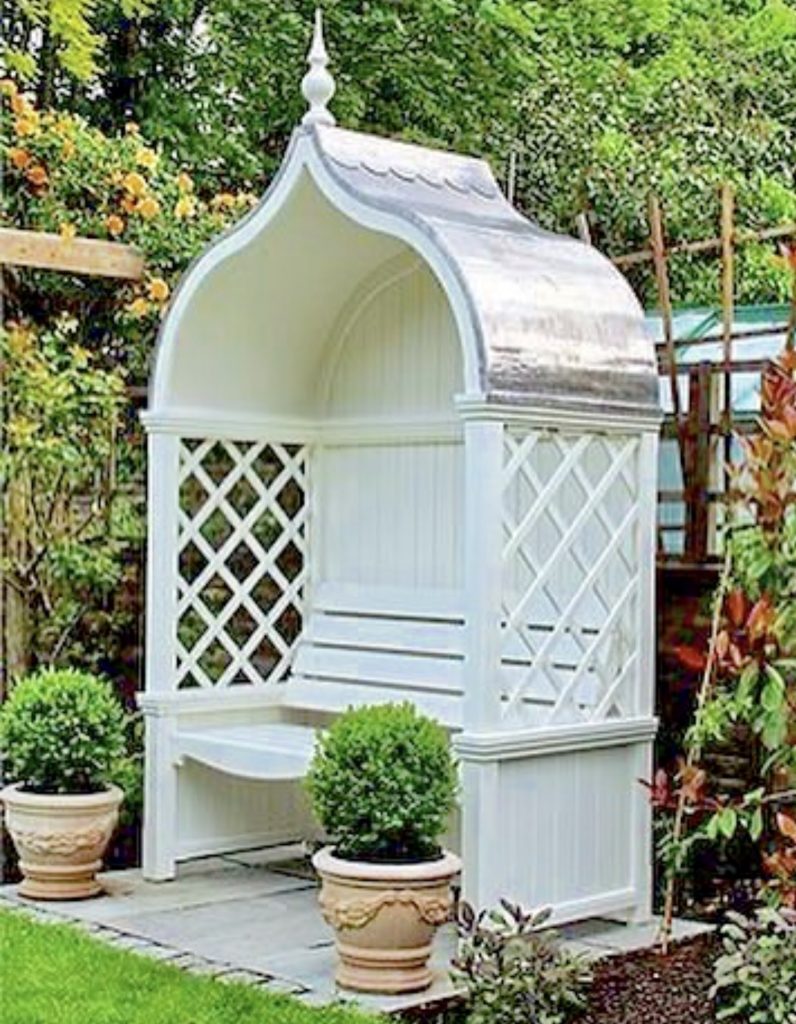
Just remember that in any garden, flowers gone wild can gobble up anything, even your garden bench! Make sure to trim those errant ramblers or you may lose your favorite seat!
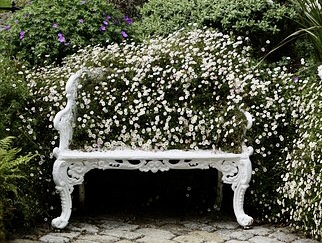
Thank you for visiting my blog! I hope you found some garden bench inspiration! If you enjoyed this post, you may also like my other gardening posts including The Secret Gardens of Historic Monterey, The Garden Gate Story: Inspiration from Carmel-by-the-Sea, Magical & Enchanting Gardens of Carmel-by-the-Sea, Charming & Romantic Window Boxes, and Add Charm to your Garden with Beautiful Birdhouses!
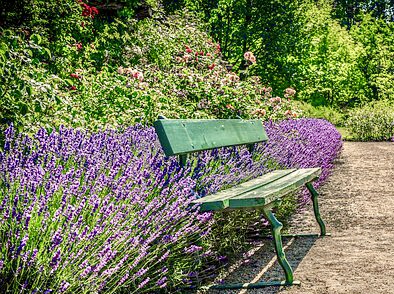
Wishing you peace, love, happiness, and beautiful vistas!
-
Add Charm to your Garden with Beautiful Birdhouses!
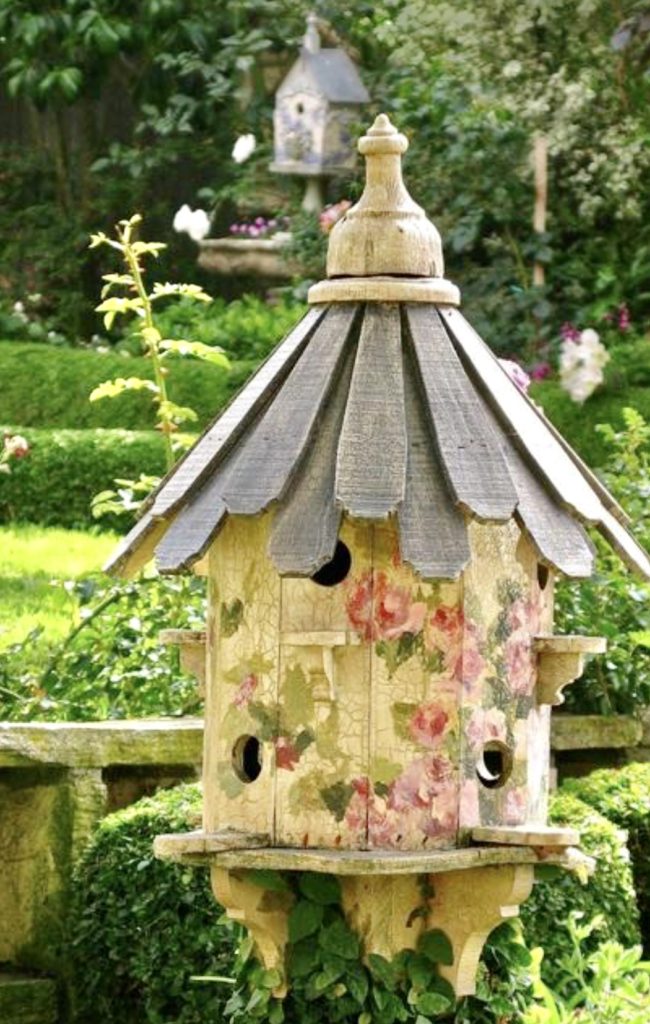
Your garden may feature the usual things: beautiful flowers and shrubs, arbors, pergolas, gates, chairs and tables, but have you thought about adding a birdhouse or two? Birdhouses not only add charm to your outdoor living space but housing birds creates endless benefits and can be immensely rewarding. Birds are wonderful companions to a garden, providing song and beauty as well as eating troublesome insects. Bird watching from your home or garden is also a relaxing and fun activity. It is a wonderful sight to behold birds building their nests and raising their babies.

Photo courtesy of homeiswheretheboatis.net 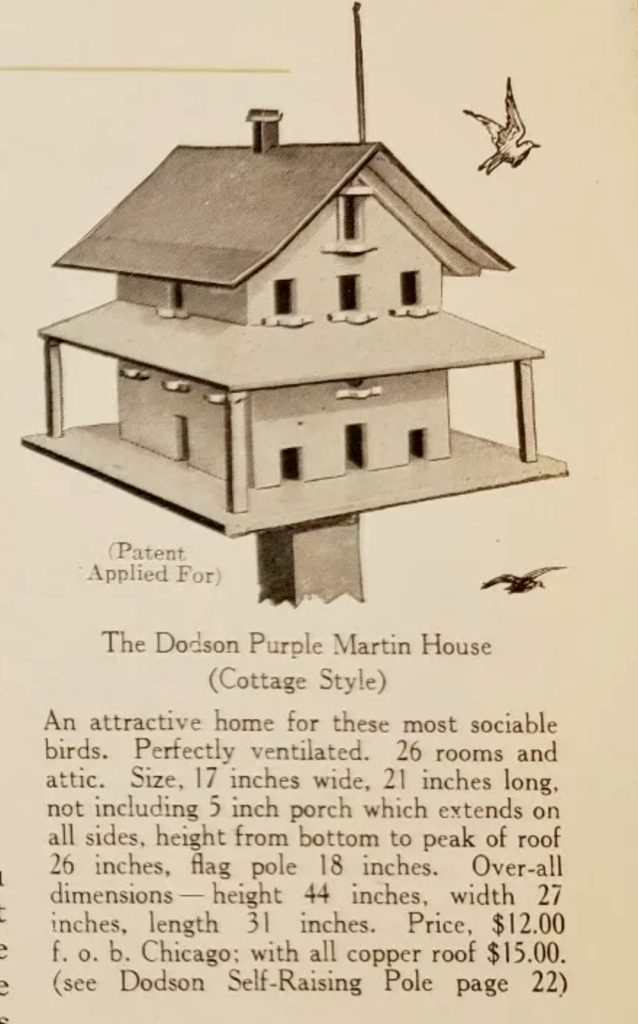
An early 1900s advertisement depicts a quaint birdhouse. Birdhouses have been around for hundreds of years. They come in all shapes and sizes, from purple martin mansions to tiny wren cottages. As birdhouses became increasingly popular, companies evolved solely for the business of building specialty bird abodes.

Photo courtesy of gardeninggonewild.com Today, there are a wide variety of wonderful birdhouses available. If you are handy with tools and equipment you can make them yourself. If not, it is very easy and convenient to purchase unfinished wooden birdhouses and paint them in the colors of your choice. Birdhouses offer a great opportunity to be creative and use your imagination. If you don’t have the time or inclination to pursue this endeavor, there are many beautiful birdhouses available for sale, many hand-made by talented artisans. The following are some of my favorites.
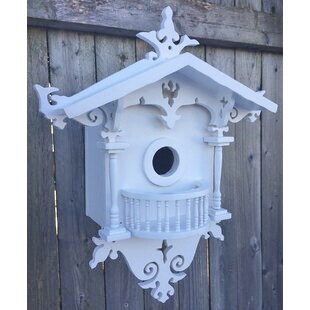
Victorian style birdhouse from wayfair.com If fancy isn’t your style, you can always repurpose. Thank outside the box, or perhaps the thermos!
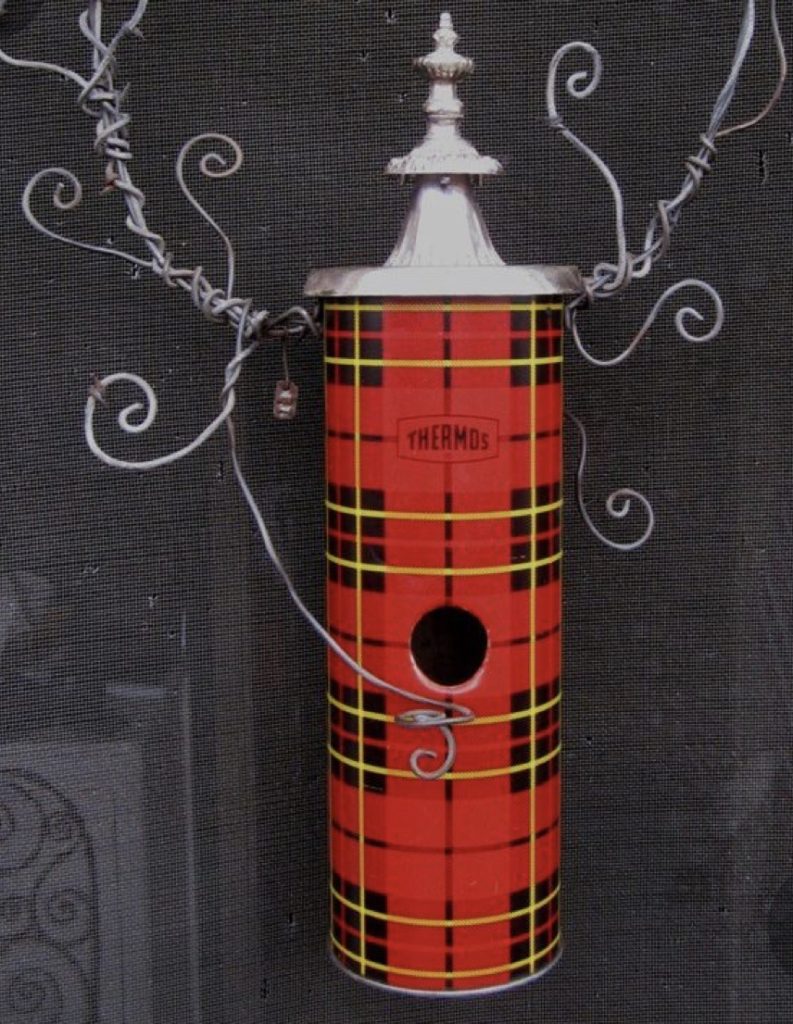
Thermos birdhouse from Etsy.com Rustic birdhouses add farmhouse flair to any garden.

Birds can have their own barn and never have to share with cows or horses, from Etsy.com 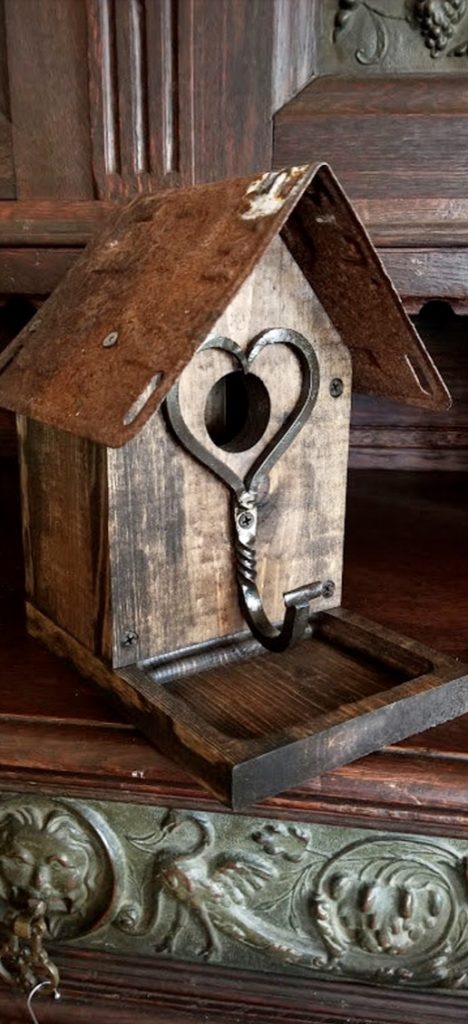
A rusty license plate roof adds shabby chic to this sweet cottage birdhouse from Etsy.com Sometimes it’s nice to incorporate natural elements into your birdhouse.
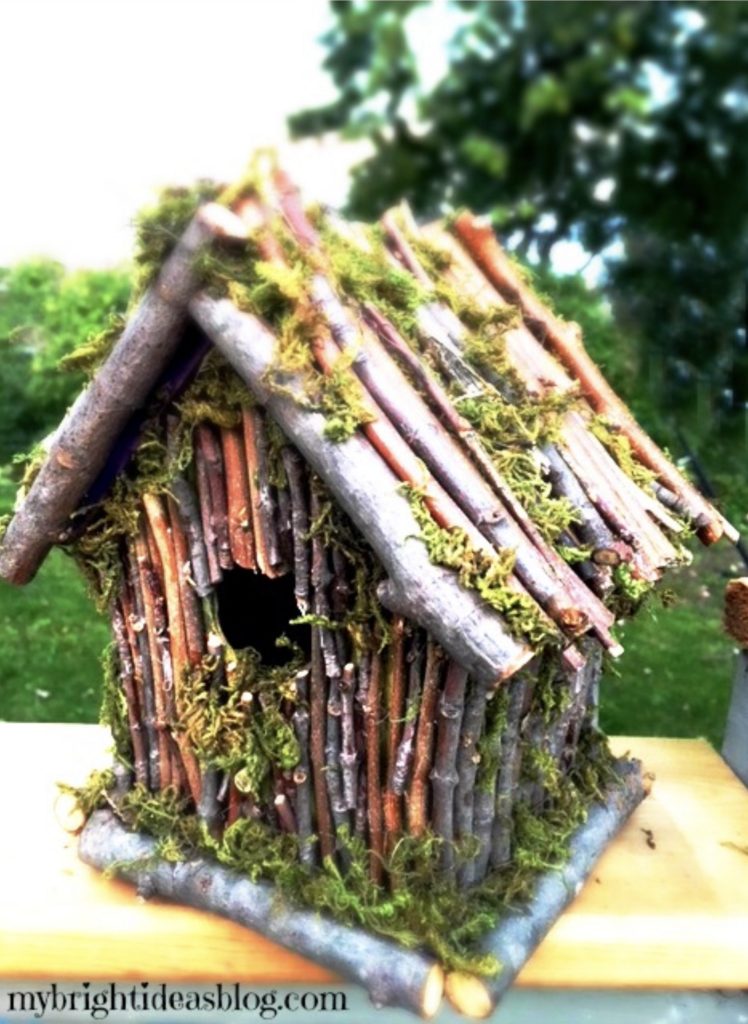
Twigs & moss make for one cozy birdhouse. Photo courtesy of mybrightideasblog.com 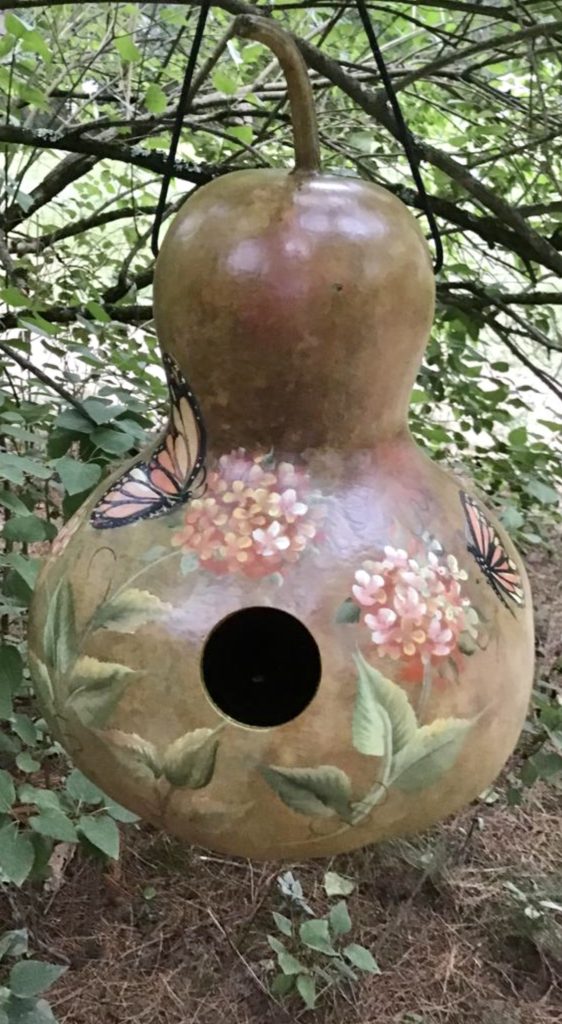
Butterflies & hydrangeas decorate this gourd birdhouse from Etsy.com I find myself drawn to the dreamy, hand-painted ones by artist Debbi Coules. Delicate pink roses on a soft white background make these birdhouses perfect for a cottage garden.
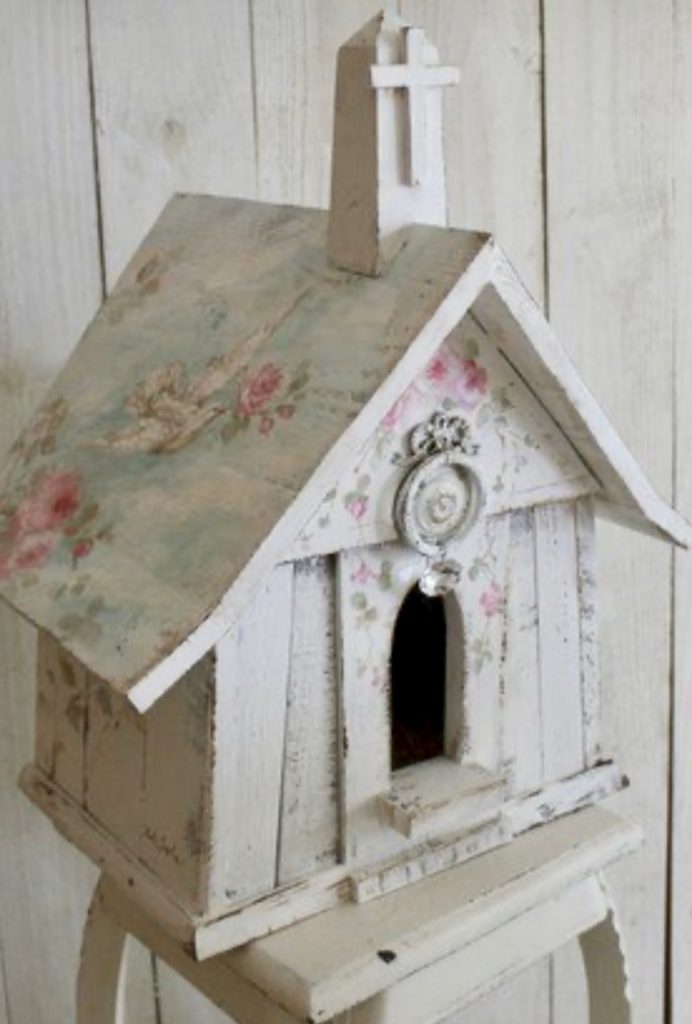
This chapel of love is perfect for a pair of lovebirds, from debicoules.com 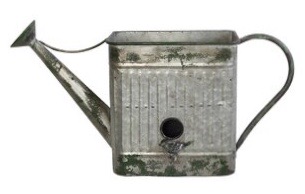
Cute & fun watering can birdhouse from wayfair.com If your heart beats for the red, white and blue, you may be enticed by a patriotic birdhouse.
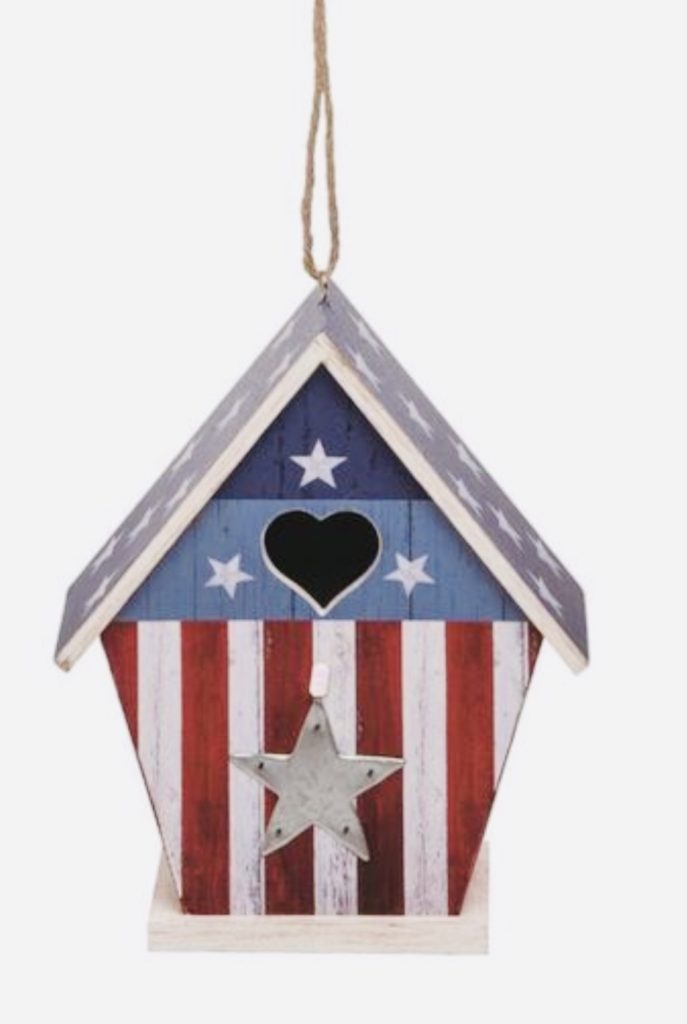
Star-spangled birdhouse from target.com No matter your style, if you can’t find it, you can create it.
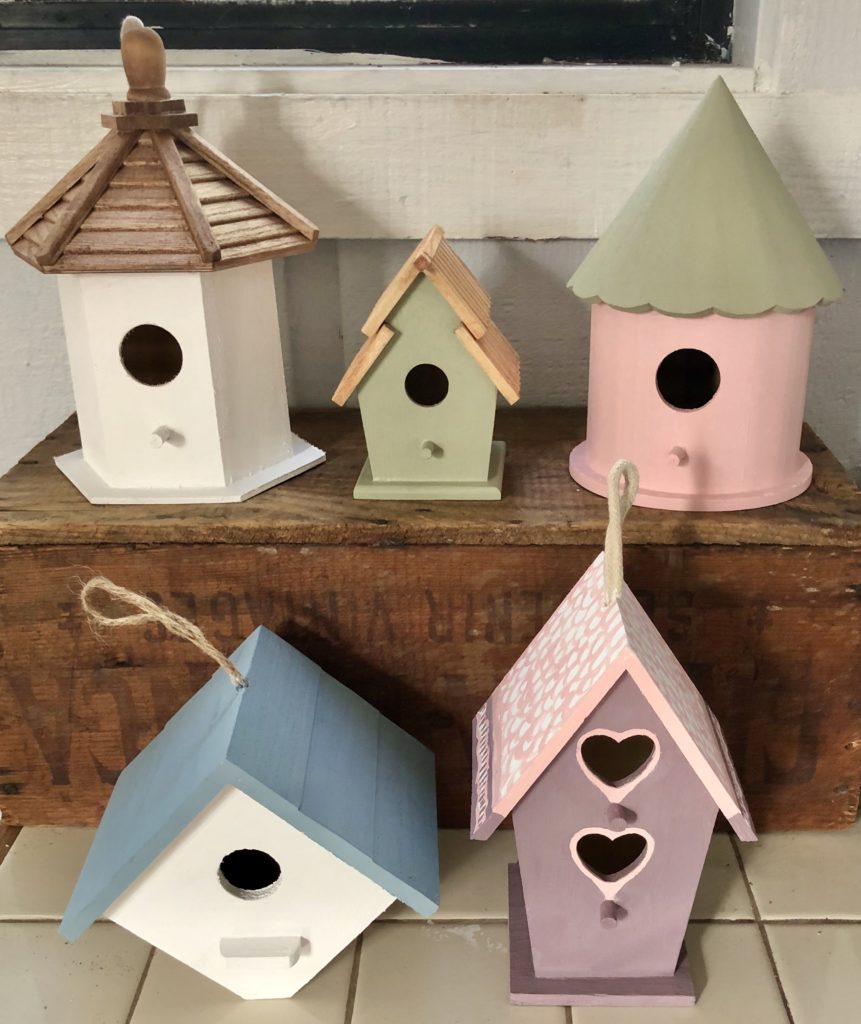
Unfinished craft store wooden birdhouses I repainted/stained. Birdhouses also make wonderful gifts. I was delighted to open a present from my Mom on my birthday and discover this cutie.
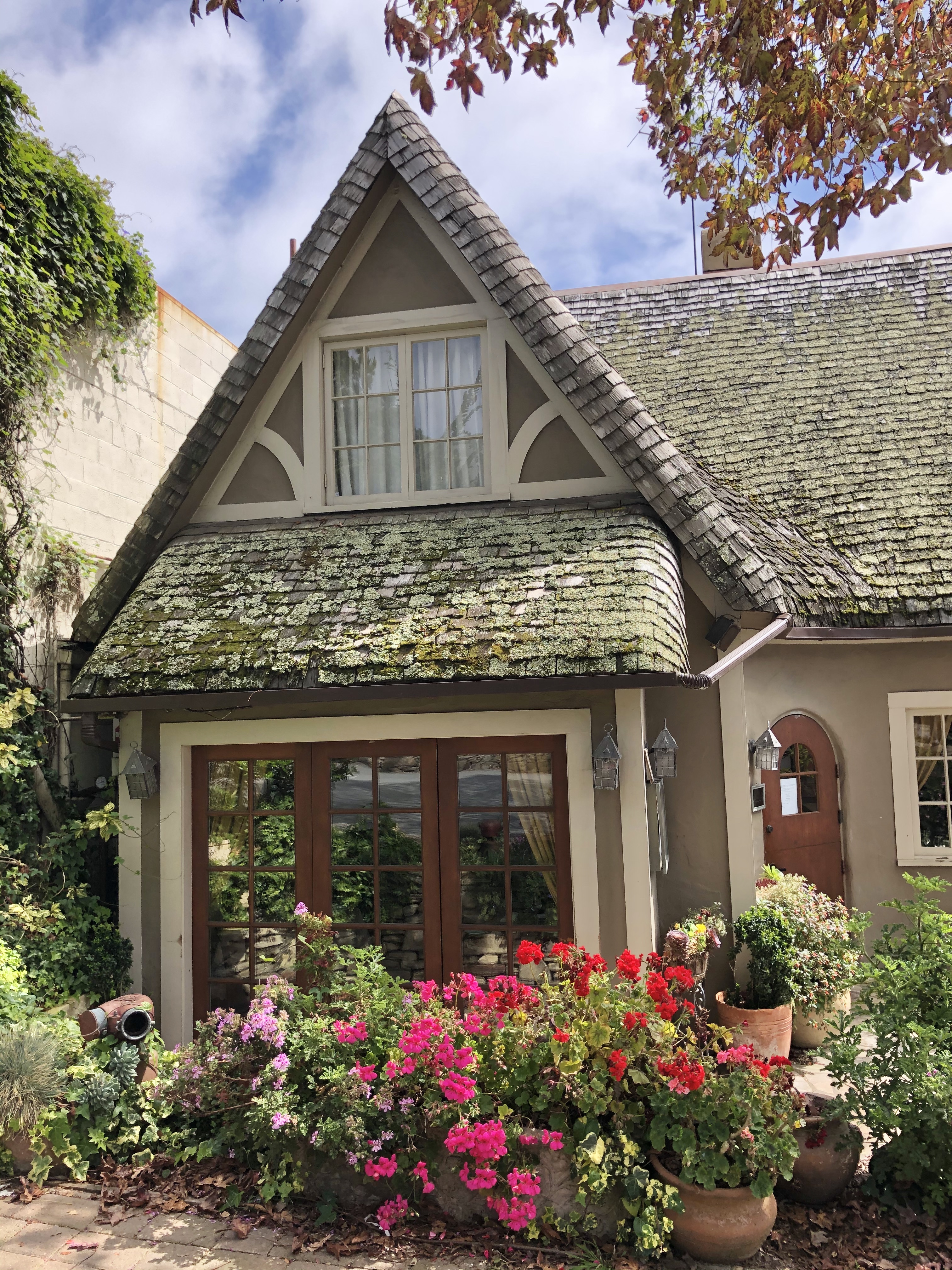
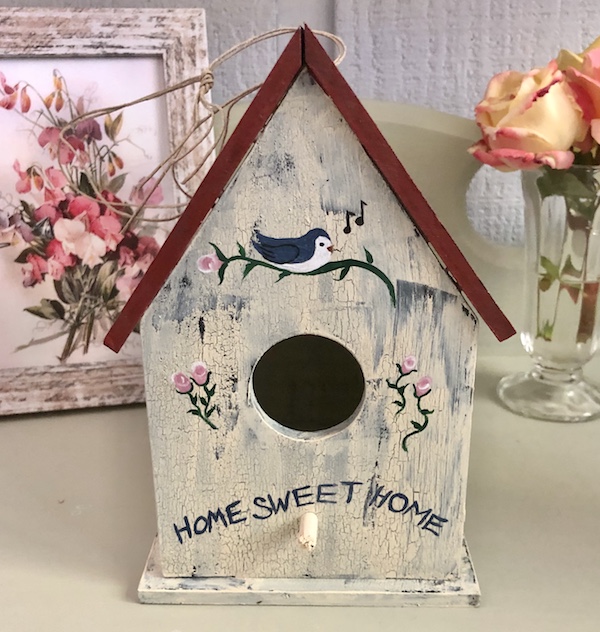
I hope you found some birdhouse inspiration on my blog. Thank you for visiting! Wishing you peace, love, happiness, and beautiful vistas!